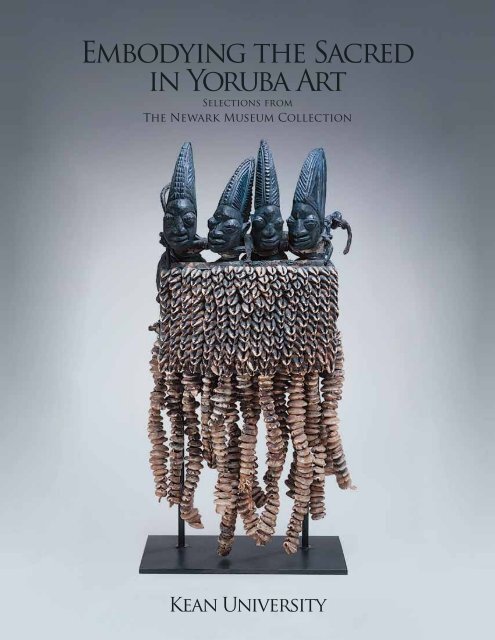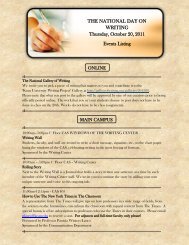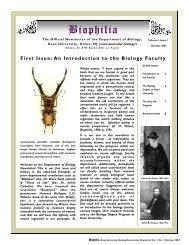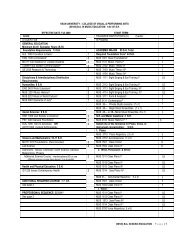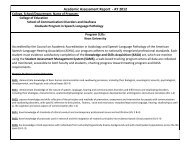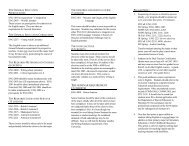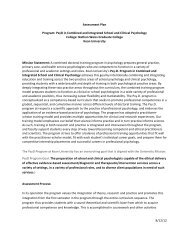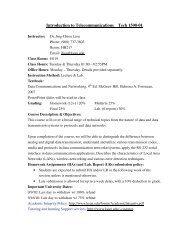Embodying the Sacred in Yoruba Art - Kean University
Embodying the Sacred in Yoruba Art - Kean University
Embodying the Sacred in Yoruba Art - Kean University
Create successful ePaper yourself
Turn your PDF publications into a flip-book with our unique Google optimized e-Paper software.
<strong>Embody<strong>in</strong>g</strong> <strong>the</strong> <strong>Sacred</strong><br />
<strong>in</strong> <strong>Yoruba</strong> <strong>Art</strong><br />
Selections from<br />
The Newark Museum Collection<br />
<strong>Kean</strong> <strong>University</strong>
<strong>Embody<strong>in</strong>g</strong> <strong>the</strong> <strong>Sacred</strong> <strong>in</strong> <strong>Yoruba</strong> <strong>Art</strong><br />
This catalog is published <strong>in</strong> conjunction with <strong>the</strong> exhibition <strong>Embody<strong>in</strong>g</strong> <strong>the</strong> <strong>Sacred</strong> <strong>in</strong> <strong>Yoruba</strong><br />
<strong>Art</strong>: Selections from <strong>the</strong> Newark Museum Collection, held at <strong>Kean</strong> <strong>University</strong> from January 31<br />
through April 18, 2012, at <strong>the</strong> Karl and Helen Burger Gallery.<br />
This exhibition is based on <strong>the</strong> show <strong>Embody<strong>in</strong>g</strong> <strong>the</strong> <strong>Sacred</strong> <strong>in</strong> <strong>Yoruba</strong> <strong>Art</strong>: Featur<strong>in</strong>g <strong>the</strong><br />
Bernard and Patricia Wagner Collection, which was jo<strong>in</strong>tly organized by <strong>the</strong> High Museum<br />
of <strong>Art</strong> <strong>in</strong> Atlanta, Georgia, and The Newark Museum <strong>in</strong> Newark, New Jersey, <strong>in</strong> 2007 and<br />
co-curated by Carol Thompson, Fred and Rita Richman Curator of African <strong>Art</strong> at <strong>the</strong> High<br />
Museum of <strong>Art</strong>, and Christa Clarke, Curator of <strong>the</strong> <strong>Art</strong>s of Africa at <strong>the</strong> Newark Museum, with<br />
an essay by Dr. Babatunde Lawal, Professor of <strong>Art</strong> History at Virg<strong>in</strong>ia Commonwealth <strong>University</strong>.<br />
Copyright © 2012 The Newark Museum. Copyright for <strong>in</strong>dividual essays is held by <strong>the</strong> authors<br />
and The Newark Museum. All rights are reserved. This book is published for educational<br />
purposes only and may not be sold or reproduced <strong>in</strong> whole or <strong>in</strong> part, <strong>in</strong> any form without<br />
written permission from The Newark Museum.<br />
Unless o<strong>the</strong>rwise noted, photographs are copyrighted by The Newark Museum.<br />
Photography:<br />
Map adapted from Babatunde Lawal, The Gèlèdé Spectacle: <strong>Art</strong>, Gender and Social Harmony <strong>in</strong><br />
an African Culture (Seattle: <strong>University</strong> of Wash<strong>in</strong>gton Press, 1996).<br />
Plate 5: Photograph by Arman<br />
Photographs on <strong>the</strong> cover, back cover, pages 4 and 6, and all plates are by Richard Goodbody.<br />
Catalogue Design and Production<br />
Paul Klonowski • paul@m<strong>in</strong>dsetcs.com<br />
Neil Tetkowski, Director of <strong>University</strong> Galleries<br />
www.kean.edu/~gallery<br />
Cover: Dance Vest with Èsù Figures, 19th–20th century, Ìgbómìnà region, Nigeria<br />
Wood, cowrie shells, lea<strong>the</strong>r, pigment, 20 3/4 x 10 x 5 1/2 <strong>in</strong>.<br />
Frontispiece: Egúngún Mask, 20th century, Nigeria, Wood, wool, metal, pigment, 12 x 8 x 6 1/2 <strong>in</strong>. (detail)
<strong>Embody<strong>in</strong>g</strong> <strong>the</strong> <strong>Sacred</strong><br />
<strong>in</strong> <strong>Yoruba</strong> <strong>Art</strong><br />
Selections from<br />
The Newark Museum Collection<br />
<strong>Kean</strong> <strong>University</strong><br />
Karl and Helen Burger Gallery<br />
Max<strong>in</strong>e and Jack Lane Center for academic success
<strong>Embody<strong>in</strong>g</strong> <strong>the</strong> <strong>Sacred</strong><br />
<strong>in</strong> <strong>Yoruba</strong> <strong>Art</strong><br />
Selections from<br />
The Newark Museum Collection<br />
January 31 - april 18, 2012<br />
<strong>Kean</strong> <strong>University</strong><br />
Karl and Helen Burger Gallery<br />
Max<strong>in</strong>e and Jack Lane Center for academic success
4<br />
Staff of Authority (Ìpawó Àse), Nigeria, brass, 14 x 5 <strong>in</strong>.
Introduction<br />
The region of West Africa that today <strong>in</strong>cludes <strong>the</strong> countries of Nigeria, Ben<strong>in</strong>, and<br />
Togo is <strong>the</strong> land of <strong>the</strong> <strong>Yoruba</strong> people, whose art is an essential and <strong>in</strong>tegral element<br />
<strong>in</strong> <strong>the</strong>ir way of life. This exhibition, <strong>Embody<strong>in</strong>g</strong> <strong>the</strong> <strong>Sacred</strong> <strong>in</strong> <strong>Yoruba</strong> <strong>Art</strong>, on view<br />
from January 31 through April 18, 2012, at <strong>Kean</strong> <strong>University</strong>’s Karl and Helen Burger<br />
Gallery, comprises twenty-eight works from <strong>the</strong> collection of <strong>the</strong> Newark Museum.<br />
The pieces <strong>in</strong> <strong>the</strong> show, which were produced from <strong>the</strong> late n<strong>in</strong>eteenth through <strong>the</strong><br />
twentieth century, highlight <strong>the</strong> relationship between art and <strong>the</strong> spiritual world.<br />
The <strong>Yoruba</strong> are among <strong>the</strong> oldest and most <strong>in</strong>fluential of all African cultures and<br />
today make up one of Africa’s largest ethnic groups. More than 25 million <strong>Yoruba</strong><br />
live <strong>in</strong> Africa, and large vibrant communities of <strong>Yoruba</strong> immigrants live <strong>in</strong> <strong>the</strong> United<br />
States and <strong>the</strong> United K<strong>in</strong>gdom. Fur<strong>the</strong>rmore, for centuries countless people of<br />
<strong>Yoruba</strong> descent have been liv<strong>in</strong>g <strong>in</strong> <strong>the</strong> Americas. The broad <strong>in</strong>fluence of <strong>Yoruba</strong><br />
culture today ranges from religious blends of Santeria to <strong>the</strong> complex rhythmic<br />
beats of Afro-Lat<strong>in</strong> and Caribbean music and even to some areas of contemporary<br />
Western art.<br />
We are privileged to be able to study <strong>the</strong>se wonderful works, removed from <strong>the</strong>ir<br />
orig<strong>in</strong>al context, from many po<strong>in</strong>ts of <strong>in</strong>terest. Clearly, <strong>the</strong> makers of <strong>the</strong> objects<br />
never <strong>in</strong>tended to show <strong>the</strong>m <strong>in</strong> <strong>the</strong> static environment of a Western art gallery;<br />
art <strong>in</strong> <strong>the</strong> <strong>Yoruba</strong> culture is created for ceremony and ritual, a means of engag<strong>in</strong>g<br />
<strong>the</strong> daily yet sacred relationship to <strong>the</strong> Earth and <strong>the</strong> spirits of <strong>the</strong> greater universe.<br />
<strong>Yoruba</strong> art gives visual form to <strong>the</strong> div<strong>in</strong>e and, <strong>in</strong> turn, <strong>in</strong>spires religious devotion.<br />
It is our <strong>in</strong>tention that this exhibition will help illum<strong>in</strong>ate our understand<strong>in</strong>g of and<br />
appreciation for <strong>the</strong> <strong>Yoruba</strong> people and <strong>the</strong>ir art.<br />
On behalf of <strong>Kean</strong> <strong>University</strong>, I wish to thank Mary Sue Sweeney Price, Director of<br />
<strong>the</strong> Newark Museum, who made it possible for us to br<strong>in</strong>g this wonderful collection<br />
of <strong>Yoruba</strong> artworks to <strong>Kean</strong> <strong>University</strong>. Our gratitude also goes to Dr. Bernard and<br />
Patricia Wagner, who generously donated <strong>the</strong> majority of works <strong>in</strong> <strong>the</strong> exhibition.<br />
We appreciate <strong>the</strong> scholarship and academic efforts of Dr. Christa Clarke and her<br />
keen selection of <strong>the</strong> works on display here. I thank Dr. Babatunde Lawal for his<br />
<strong>in</strong>sightful essay. For coord<strong>in</strong>at<strong>in</strong>g <strong>the</strong> show and <strong>the</strong> catalogue project, we thank<br />
Zette Emmons and Michael Schumacher at <strong>the</strong> Newark Museum, and for <strong>the</strong>ir<br />
work <strong>in</strong> plann<strong>in</strong>g and coord<strong>in</strong>at<strong>in</strong>g, we are grateful to graduate assistants Diana<br />
Palermo and Joshua Green. We wish to thank Danny Aviram from <strong>the</strong> Facilities<br />
Department and gallery assistants Afieya Kipp and Tazwell Salter for <strong>in</strong>stall<strong>in</strong>g <strong>the</strong><br />
show. A special note of thanks also goes to Dr. Dawood Farahi, President of <strong>Kean</strong><br />
<strong>University</strong>, and Holly Logue, Act<strong>in</strong>g Dean of <strong>the</strong> School of Visual and Perform<strong>in</strong>g<br />
<strong>Art</strong>s. We appreciate <strong>the</strong>ir support for <strong>Kean</strong>’s grow<strong>in</strong>g exhibition program and for<br />
this opportunity to <strong>in</strong>vestigate <strong>the</strong> art and culture of <strong>the</strong> <strong>Yoruba</strong> people.<br />
Neil Tetkowski<br />
Director of <strong>University</strong> Galleries<br />
5
<strong>Yoruba</strong> <strong>Art</strong> <strong>in</strong> <strong>the</strong> Newark Museum<br />
The African art collection <strong>in</strong> <strong>the</strong> Newark Museum was established <strong>in</strong> <strong>the</strong> first<br />
decades of <strong>the</strong> twentieth century and is thus one of <strong>the</strong> oldest collections <strong>in</strong><br />
<strong>the</strong> United States. Indeed, art of <strong>the</strong> <strong>Yoruba</strong> is prom<strong>in</strong>ent among <strong>the</strong> museum’s<br />
earliest acquisitions; <strong>in</strong> 1924 <strong>the</strong> museum purchased <strong>the</strong> collection of Walter<br />
Dormitzer, a New Jersey bus<strong>in</strong>essman who worked <strong>in</strong> West Africa dur<strong>in</strong>g <strong>the</strong><br />
late n<strong>in</strong>eteenth century. Not<strong>in</strong>g at <strong>the</strong> time that “not very much attention has<br />
been paid to primitive Africa by museums [sic],” <strong>the</strong> Newark Museum signified<br />
its serious commitment to develop<strong>in</strong>g an African art collection with this acquisition.<br />
Also <strong>in</strong> 1924, <strong>the</strong> museum’s founder, John Cotton Dana, acquired one of <strong>the</strong><br />
collection’s outstand<strong>in</strong>g sculptural works, a masterful div<strong>in</strong>ation cup <strong>in</strong> <strong>the</strong> form<br />
of a mounted warrior. These and o<strong>the</strong>r examples of <strong>Yoruba</strong> art were highlighted<br />
<strong>in</strong> <strong>the</strong> Newark Museum’s first exhibition of African art, which was held to <strong>in</strong>augurate<br />
its new build<strong>in</strong>g <strong>in</strong> 1926 and acknowledged as one of <strong>the</strong> first museum<br />
exhibitions devoted to <strong>the</strong> subject.<br />
Over <strong>the</strong> decades, <strong>the</strong> Newark Museum’s representation of <strong>Yoruba</strong> art has<br />
expanded considerably to <strong>in</strong>clude f<strong>in</strong>e examples of textiles and beadwork<br />
along with sculpture <strong>in</strong> wood, clay, and metal. Most recently, our representation<br />
of <strong>Yoruba</strong> artistic creation has embraced <strong>the</strong> Diaspora, particularly those<br />
contemporary traditions found <strong>in</strong> New Jersey. In 2000 <strong>the</strong> Newark Museum<br />
commissioned and subsequently acquired an altar dedicated to Chango<br />
(known as Sàngó among <strong>the</strong> <strong>Yoruba</strong>) created by Eric Rucker, a practitioner<br />
based <strong>in</strong> Newark. This acquisition was followed <strong>in</strong> 2004 by <strong>the</strong> purchase of<br />
two appliquéd and beaded pañelos dedicated to Chango and Yemeya (called<br />
Yemoja by <strong>Yoruba</strong>) created by Cuban artist Alberto Morgan, a New Jersey<br />
resident and Santeria practitioner. Most recently, <strong>the</strong> important gifts from<br />
Bernard and Patricia Wagner featured <strong>in</strong> this exhibition established <strong>the</strong><br />
Newark Museum as one of <strong>the</strong> nation’s lead<strong>in</strong>g repositories of <strong>Yoruba</strong> art,<br />
a collection dist<strong>in</strong>guished by its depth and breadth of representation.<br />
In 2008 <strong>the</strong> museum celebrated this major donation <strong>in</strong> <strong>the</strong> exhibition<br />
<strong>Embody<strong>in</strong>g</strong> <strong>the</strong> <strong>Sacred</strong> <strong>in</strong> <strong>Yoruba</strong> <strong>Art</strong>: Featur<strong>in</strong>g <strong>the</strong> Bernard and Patricia<br />
Wagner Collection, co-organized with <strong>the</strong> High Museum <strong>in</strong> Atlanta, also a<br />
recipient of <strong>the</strong> Wagners’ generosity. Because “embody<strong>in</strong>g <strong>the</strong> sacred<br />
<strong>in</strong> <strong>Yoruba</strong> art” is <strong>the</strong> conceptual basis for this new exhibition, <strong>the</strong><br />
Opposite: Epa Headdress, Èkìtì Region, Nigeria. Attributed to Bamgboye of Odò Owá (1888 –1978), 21 <strong>in</strong>. high<br />
7
Newark Museum acknowledges <strong>the</strong> many contributions of <strong>the</strong> staff<br />
of <strong>the</strong> High Museum. In particular, we thank Carol Thompson, Fred<br />
and Rita Richman Curator of African <strong>Art</strong> at <strong>the</strong> High Museum, who<br />
organized <strong>the</strong> exhibition along with Newark Museum curator Christa<br />
Clarke, and graphic designer Angela Jaeger, who produced <strong>the</strong> orig<strong>in</strong>al<br />
catalogue. We are also grateful to Dr. Babatunde Lawal, Professor of<br />
<strong>Art</strong> History at Virg<strong>in</strong>ia Commonwealth <strong>University</strong>, who developed <strong>the</strong><br />
conceptual framework of <strong>the</strong> 2008 exhibition and wrote <strong>the</strong> catalogue<br />
essay, a version of which is published here. At <strong>the</strong> Newark Museum,<br />
I thank Christa Clarke, Curator, <strong>Art</strong>s of Africa, and Senior Curator,<br />
<strong>Art</strong>s of Africa and <strong>the</strong> Americas; Zette Emmons, Manager of Travel<strong>in</strong>g<br />
Exhibitions; and U. Michael Schumacher, Market<strong>in</strong>g Communications<br />
Manager, for guid<strong>in</strong>g this exhibition. Special thanks also go to <strong>Kean</strong><br />
<strong>University</strong> President Dawood Farahi; Holly Logue, Act<strong>in</strong>g Dean of <strong>the</strong><br />
College of Visual and Perform<strong>in</strong>g <strong>Art</strong>s; and Neil Tetkowski, Director of<br />
<strong>University</strong> Galleries, for br<strong>in</strong>g<strong>in</strong>g this exhibition to <strong>the</strong>ir campus and<br />
mak<strong>in</strong>g this catalogue possible.<br />
Mary Sue Sweeney Price<br />
Director, The Newark Museum<br />
Opposite: Epa Headdress, Èkìtì Region, Nigeria. Attributed to Bamgboye of Odò Owá (1888–1978), 21 <strong>in</strong>. high (detail)<br />
9
10<br />
Map of <strong>Yoruba</strong>land, show<strong>in</strong>g major towns (e.g. Ìlé Ifè) and subgroups (e.g. ÌFÈ)
<strong>Embody<strong>in</strong>g</strong> <strong>the</strong> <strong>Sacred</strong> <strong>in</strong> <strong>Yoruba</strong> <strong>Art</strong><br />
By Babatunde Lawal<br />
The <strong>in</strong>terconnectedness of art and life <strong>in</strong> Africa is evident <strong>in</strong> many<br />
African cosmologies that not only trace <strong>the</strong> orig<strong>in</strong> of art to a High God or<br />
Supreme Div<strong>in</strong>ity or supernatural be<strong>in</strong>gs but also identify <strong>the</strong> human body<br />
as a piece of sculpture animated by a vital force or soul. Little wonder that<br />
<strong>the</strong> Ewe of Togo and Ghana, for <strong>in</strong>stance, call a human be<strong>in</strong>g amegbeto<br />
(liv<strong>in</strong>g molded clay). 1 In o<strong>the</strong>r words, an <strong>in</strong>dividual is alive as long as <strong>the</strong><br />
soul dwells <strong>in</strong> his or her body, and death results when <strong>the</strong> soul leaves that<br />
body. However, <strong>in</strong> many African cultures, death is not <strong>the</strong> end of life but<br />
ra<strong>the</strong>r a transition from physical to metaphysical existence, where, accord<strong>in</strong>g<br />
to popular belief, a dematerialized soul lives on and may re<strong>in</strong>carnate<br />
as a newborn baby. In effect, <strong>the</strong> body mediates and recycles life on earth;<br />
hence it is frequently stylized <strong>in</strong> African art to signify different phases of<br />
<strong>the</strong> existential process, to make <strong>the</strong> <strong>in</strong>tangible tangible, and to engender<br />
cherished social, spiritual, and aes<strong>the</strong>tic values. 2 This exhibition focuses<br />
on <strong>the</strong> manifestation of k<strong>in</strong>dred notions <strong>in</strong> examples of <strong>Yoruba</strong> art from <strong>the</strong><br />
Newark Museum.<br />
The <strong>Yoruba</strong><br />
The <strong>Yoruba</strong>, one of <strong>the</strong> largest ethnic groups <strong>in</strong> Africa, number more<br />
than twenty-five million people today and live ma<strong>in</strong>ly <strong>in</strong> Nigeria and<br />
<strong>the</strong> republics of Ben<strong>in</strong> and Togo (p. 10). They are made up of several<br />
k<strong>in</strong>gdoms, each headed by a k<strong>in</strong>g. Abundant natural resources enabled<br />
<strong>the</strong>m to develop one of <strong>the</strong> most complex cultures <strong>in</strong> sub-Saharan<br />
Africa. By <strong>the</strong> beg<strong>in</strong>n<strong>in</strong>g of <strong>the</strong> second millennium CE, Ilé-Ifè, <strong>the</strong>ir most<br />
sacred city, had become a major urban center with highly sophisticated<br />
religious, social, and political <strong>in</strong>stitutions. The ancient arts of Ilè-Ifè<br />
<strong>in</strong>clude extremely naturalistic terra-cotta and bronze sculptures dat<strong>in</strong>g<br />
from <strong>the</strong> eleventh to <strong>the</strong> sixteenth century, h<strong>in</strong>t<strong>in</strong>g at an era of economic<br />
prosperity and <strong>in</strong>tense cultural activity. 3 Although <strong>Yoruba</strong> culture appears<br />
to be homogeneous, <strong>the</strong>re are significant regional variations, which<br />
suggest that what we have today is a syn<strong>the</strong>sis of previously diverse,<br />
if related, elements. 4<br />
11
12<br />
Ontological Significance of <strong>Art</strong><br />
In order to fully understand <strong>the</strong> centrality of art (onà) <strong>in</strong> <strong>Yoruba</strong> thought,<br />
one must be aware of <strong>the</strong>ir cosmology, which traces <strong>the</strong> orig<strong>in</strong> of existence<br />
(ìwà) to a Supreme Div<strong>in</strong>ity called Olódùmarè, <strong>the</strong> generator of àse, <strong>the</strong><br />
enabl<strong>in</strong>g power that susta<strong>in</strong>s and transforms <strong>the</strong> universe. It abides <strong>in</strong> all<br />
th<strong>in</strong>gs — animate or <strong>in</strong>animate, visible or <strong>in</strong>visible. Àse is <strong>the</strong> vital force that<br />
enables <strong>the</strong> sun to sh<strong>in</strong>e, <strong>the</strong> fire to burn, <strong>the</strong> w<strong>in</strong>d to blow, <strong>the</strong> ra<strong>in</strong> to fall,<br />
<strong>the</strong> river to flow and so on. Assist<strong>in</strong>g Olódùmarè <strong>in</strong> adm<strong>in</strong>ister<strong>in</strong>g <strong>the</strong> universe<br />
are a number of deities called òrìsà, each personify<strong>in</strong>g <strong>the</strong> àse immanent <strong>in</strong><br />
a natural or cultural phenomenon. For example, Yemoja personifies water<br />
and mo<strong>the</strong>rhood; Obàtálá, creativity; Orúnmìlà, wisdom and clairvoyance;<br />
Èsù/Elégba, mediation 5 ; Odùduwà, div<strong>in</strong>e k<strong>in</strong>gship; Òsányìn, curative medic<strong>in</strong>e;<br />
Ògún, tools, weapons, and warfare; Òrìsa Oko, agriculture; Sàngó, thunderstorms<br />
and social justice; Oya, tornados; Òsun, fertility and beauty, to name<br />
only a few. As a result, <strong>Yoruba</strong> religion focuses on <strong>the</strong> veneration of <strong>the</strong> òrìsà<br />
because <strong>the</strong>y adm<strong>in</strong>ister <strong>the</strong> cosmos on behalf of Olódùmarè. It is to <strong>the</strong><br />
òrìsà that shr<strong>in</strong>es are built and sacrifices offered. 6<br />
Creation and <strong>the</strong> Orig<strong>in</strong> of <strong>Art</strong>istic Creativity<br />
Accord<strong>in</strong>g to <strong>Yoruba</strong> cosmology, only <strong>the</strong> heavens existed <strong>in</strong> <strong>the</strong> beg<strong>in</strong>n<strong>in</strong>g.<br />
On decid<strong>in</strong>g to create land below <strong>the</strong> sky, Olódùmarè gave Odùduwà (<strong>the</strong><br />
òrìsà of div<strong>in</strong>e k<strong>in</strong>gship) a bag of sand and a bird with which to perform <strong>the</strong><br />
task. Odùduwà <strong>the</strong>n descended from <strong>the</strong> sky by a cha<strong>in</strong>, poured <strong>the</strong> sand<br />
on <strong>the</strong> primordial waters, and placed <strong>the</strong> bird on it. The latter spread <strong>the</strong><br />
sand <strong>in</strong> different directions, eventually creat<strong>in</strong>g <strong>the</strong> earth. This expla<strong>in</strong>s why<br />
Odùduwà is sometimes venerated as <strong>the</strong> div<strong>in</strong>e ancestor of <strong>Yoruba</strong> k<strong>in</strong>gs or<br />
as an Earth goddess (Ilè).<br />
To <strong>the</strong> <strong>Yoruba</strong>, art began when Olódùmarè commissioned <strong>the</strong> creativity<br />
deity Obàtálá to mold <strong>the</strong> first human image from clay. Upon receiv<strong>in</strong>g a<br />
soul (èmí ) from Olódùmarè, <strong>the</strong> image turned <strong>in</strong>to a liv<strong>in</strong>g fetus and was<br />
<strong>the</strong>n placed <strong>in</strong>side <strong>the</strong> womb of a pregnant woman to develop <strong>in</strong>to a baby.<br />
So <strong>the</strong> soul is a k<strong>in</strong>d of àse empower<strong>in</strong>g <strong>the</strong> body <strong>in</strong> <strong>the</strong> physical world. In<br />
fact, some <strong>Yoruba</strong> oral traditions trace <strong>the</strong> orig<strong>in</strong> of humanity to <strong>the</strong> Supreme<br />
Div<strong>in</strong>ity’s desire to transform <strong>the</strong> primeval wilderness below <strong>the</strong> sky <strong>in</strong>to an<br />
orderly state. This desire reverberates <strong>in</strong> <strong>the</strong> <strong>Yoruba</strong> word for human be<strong>in</strong>g,<br />
ènìyàn, which translates as “those specially selected” to convey goodness<br />
(ire) to <strong>the</strong> earth. 7 In fact, Obàtálá himself and some òrìsà allegedly assumed<br />
<strong>the</strong> same human form <strong>in</strong> order to accompany <strong>the</strong> first mortals to <strong>the</strong> earth.<br />
The myth not only relates art to life, but it also identifies <strong>the</strong> capacity to create<br />
and appreciate art as an <strong>in</strong>tegral part of humanity, transform<strong>in</strong>g what was<br />
once a primordial jungle <strong>in</strong>to its present advanced stage of development.
Naturalism and Abstraction <strong>in</strong> <strong>Yoruba</strong> <strong>Art</strong><br />
So it is that <strong>the</strong> artist (onísé onà) plays an important role <strong>in</strong> <strong>Yoruba</strong><br />
culture, serv<strong>in</strong>g as an agent for translat<strong>in</strong>g time-honored values <strong>in</strong>to visual<br />
metaphors aimed at susta<strong>in</strong><strong>in</strong>g humanity <strong>in</strong> body and spirit. An apprentice<br />
beg<strong>in</strong>s by observ<strong>in</strong>g a master artist at work and practic<strong>in</strong>g under close<br />
supervision. He or she is allowed to turn professional after demonstrat<strong>in</strong>g<br />
enough technical mastery of forms and sufficient knowledge of <strong>the</strong>ir<br />
cultural and ritual contexts. 3 Although <strong>the</strong>re are <strong>in</strong>dividual and regional<br />
variations <strong>in</strong> <strong>Yoruba</strong> art, two ma<strong>in</strong> idioms are discernible—<strong>the</strong> naturalistic<br />
and <strong>the</strong> stylized. In naturalistic images (àyàjora, mean<strong>in</strong>g similitude), <strong>the</strong><br />
artist attempts to capture a recognizable (though idealized) likeness of<br />
<strong>the</strong> subject. A good example is <strong>the</strong> memorial effigy (àkó, àjèjé ) that vivifies<br />
<strong>the</strong> presence of a recently dead person whose corpse has been buried.<br />
The effigy is used <strong>in</strong> a second burial ceremony to enable friends and<br />
relations to pay <strong>the</strong>ir f<strong>in</strong>al respects to <strong>the</strong> deceased and to wish him or her<br />
a happy retirement <strong>in</strong> Èhìn Ìwà, <strong>the</strong> Afterlife. S<strong>in</strong>ce <strong>the</strong> effigy is normally<br />
costumed, <strong>the</strong> carver pays most attention to <strong>the</strong> head, forearms, and legs<br />
and leaves o<strong>the</strong>r parts of <strong>the</strong> body relatively unf<strong>in</strong>ished. Dressed <strong>in</strong> f<strong>in</strong>e<br />
clo<strong>the</strong>s, <strong>the</strong> effigy is first displayed <strong>in</strong> <strong>the</strong> former residence of <strong>the</strong> deceased<br />
and treated as if it were alive—greeted and eulogized. After <strong>the</strong> ceremony,<br />
<strong>the</strong> effigy is buried like a corpse or abandoned <strong>in</strong> <strong>the</strong> forest. 8<br />
By contrast, stylized or conceptual representations (àròyá, mean<strong>in</strong>g<br />
abstraction) are not so much concerned with physical resemblance as with<br />
realities beyond <strong>the</strong> visible. This is especially true of altar figures and o<strong>the</strong>r<br />
images <strong>in</strong>tended to signify supernatural be<strong>in</strong>gs and disembodied souls.<br />
Ère ìbejì, memorials (pls. 6, checklist 23a–b, 24a–b) dedicated to deceased<br />
tw<strong>in</strong>s, belong <strong>in</strong> this category. Underly<strong>in</strong>g <strong>the</strong>ir creation is <strong>the</strong> ancient <strong>Yoruba</strong><br />
belief that even though tw<strong>in</strong>s (ìbejì ) are physically two <strong>in</strong>dividuals, metaphysically<br />
<strong>the</strong>y are one. If one tw<strong>in</strong> should die prematurely, tradition requires that<br />
a memorial be made to localize <strong>the</strong> soul of <strong>the</strong> deceased (pl. 6). Reflect<strong>in</strong>g<br />
<strong>the</strong> sex of <strong>the</strong> deceased, <strong>the</strong> memorial is usually kept on an altar, a safe place<br />
<strong>in</strong> <strong>the</strong> house or sometimes given to <strong>the</strong> surviv<strong>in</strong>g tw<strong>in</strong> to play with like a doll.<br />
One of its ritual functions is to ma<strong>in</strong>ta<strong>in</strong> a spiritual bond between <strong>the</strong> liv<strong>in</strong>g<br />
and deceased tw<strong>in</strong>. If <strong>the</strong> second tw<strong>in</strong> should die (checklist 23a–b, 24a–b),<br />
<strong>the</strong> parents would commission ano<strong>the</strong>r memorial and cont<strong>in</strong>ue to treat both<br />
as liv<strong>in</strong>g children <strong>in</strong> <strong>the</strong> hope that <strong>the</strong>ir souls will cont<strong>in</strong>ue to bless and protect<br />
<strong>the</strong>m. Tradition requires a carver to give identical facial features to memorials<br />
for tw<strong>in</strong>s <strong>in</strong> order to reflect and celebrate <strong>the</strong> oneness <strong>in</strong> <strong>the</strong>ir twoness. 9<br />
Accord<strong>in</strong>g <strong>the</strong> Head Its Due<br />
The prom<strong>in</strong>ence given to <strong>the</strong> head (orí ) <strong>in</strong> <strong>Yoruba</strong> sculpture (pls. 6, 7,<br />
13, 19) can be traced to a number of factors. First, it is <strong>the</strong> location of <strong>the</strong><br />
13
14<br />
bra<strong>in</strong> (<strong>the</strong> seat of wisdom and reason), <strong>the</strong> eyes (<strong>the</strong> lamps that guide a<br />
person through <strong>the</strong> dark jungle of life), <strong>the</strong> nose (<strong>the</strong> source of ventilation for<br />
<strong>the</strong> soul), <strong>the</strong> mouth (<strong>the</strong> source of nourishment for <strong>the</strong> body), and <strong>the</strong> ears<br />
(<strong>the</strong> detectors of sound). Second, <strong>the</strong> head is a site of identity, perception,<br />
and communication. Third, and most important, <strong>the</strong> <strong>Yoruba</strong> regard <strong>the</strong> head<br />
as <strong>the</strong> po<strong>in</strong>t through which <strong>the</strong> soul, <strong>the</strong> life-giv<strong>in</strong>g àse from <strong>the</strong> Supreme<br />
Div<strong>in</strong>ity (Olódùmarè), enters <strong>the</strong> body. Hence <strong>the</strong> head is to an <strong>in</strong>dividual what<br />
Olódùmarè is to <strong>the</strong> cosmos—a source of power — a metaphor re<strong>in</strong>forced by<br />
<strong>the</strong> <strong>Yoruba</strong> word oríladé (<strong>the</strong> head is a crown). Note <strong>the</strong> crownlike coiffures<br />
and headgears of many <strong>Yoruba</strong> figure sculptures.<br />
Adé Oba: The Monarch’s Beaded Crown<br />
As <strong>the</strong> k<strong>in</strong>g (oba) is metaphorically <strong>the</strong> head of a town, he may wear<br />
an elaborate costume and a beaded crown with a veil (adé), which transforms<br />
him <strong>in</strong>to a masked figure. The bird motif on most crowns (pl. 1)<br />
has layers of mean<strong>in</strong>g. It recalls how Odùduwà, assisted by a mythical<br />
bird, created habitable land on <strong>the</strong> primordial waters at Ilé-Ifè, where he<br />
eventually became <strong>the</strong> first k<strong>in</strong>g. It also emblematizes <strong>the</strong> role of <strong>the</strong> k<strong>in</strong>g<br />
as an <strong>in</strong>termediary between his subjects and <strong>the</strong> òrìsà, <strong>in</strong> <strong>the</strong> same way<br />
that a bird mediates between heaven and earth. And, fur<strong>the</strong>r, it alludes to<br />
a mystical power (àse) that Olòdúmarè reportedly gave to <strong>the</strong> first female<br />
(<strong>in</strong> <strong>the</strong> form of a bird enclosed <strong>in</strong> a calabash), thus allow<strong>in</strong>g her to counterbalance<br />
<strong>the</strong> muscular advantage of men. This mystical power is said to be<br />
responsible not only for her ability to procreate but also for her capacity to<br />
turn <strong>in</strong>to a bird at night to do good or evil. Thus, by hav<strong>in</strong>g a symbol of<br />
archetypal female power on his crown, a k<strong>in</strong>g is expected to manipulate<br />
that power for <strong>the</strong> good of all. This expla<strong>in</strong>s why <strong>the</strong> Ìyá Oba (Official<br />
Mo<strong>the</strong>r of <strong>the</strong> K<strong>in</strong>g) crowns a new monarch <strong>in</strong> some towns — to underscore<br />
<strong>the</strong> fact that he has <strong>the</strong> support of <strong>the</strong> women.<br />
A typical crown has a stylized face designed to identify <strong>the</strong> k<strong>in</strong>g <strong>in</strong> public.<br />
Some have more than one face (pl. 1). Frequently associated with Odùduwà,<br />
<strong>the</strong> face — or a similar one, should <strong>the</strong> crown be replaced—identified his<br />
predecessors and will do <strong>the</strong> same for his successors. It is this face that<br />
signifies <strong>the</strong> cont<strong>in</strong>uity of <strong>the</strong> office, regardless of who may hold it at a<br />
particular po<strong>in</strong>t <strong>in</strong> time. Faces may also be depicted on o<strong>the</strong>r forms of<br />
royal regalia, such as <strong>the</strong> k<strong>in</strong>g’s robe, beaded slippers, and foot cushion<br />
(pl. 4a-c), to h<strong>in</strong>t at <strong>the</strong> all-see<strong>in</strong>g power of <strong>the</strong> monarch and his mental<br />
and spiritual capacity to provide good leadership.<br />
Some crowns (called oríkògbófo) may reflect <strong>the</strong> personal taste of a<br />
k<strong>in</strong>g. These vary from <strong>the</strong> “dog-eared-one” (abetíajá), which is worn <strong>in</strong>
such a way that <strong>the</strong> faces are oriented sideways, (pl. 2) to caps shaped<br />
like pillboxes, European crowns, and coronets. O<strong>the</strong>r crowns were <strong>in</strong>fluenced<br />
by European style lawyer’s wigs (checklist 27), reflect<strong>in</strong>g <strong>the</strong> radical<br />
changes that occurred <strong>in</strong> <strong>Yoruba</strong>land between <strong>the</strong> late n<strong>in</strong>eteenth century<br />
and 1960, when <strong>the</strong> k<strong>in</strong>gs lost much of <strong>the</strong>ir political power to French and<br />
British colonial adm<strong>in</strong>istrations. Although <strong>the</strong>ir position is largely ceremonial<br />
today, k<strong>in</strong>gs are still consulted by <strong>the</strong> state government before certa<strong>in</strong><br />
decisions are made. A wig-like crown presents a k<strong>in</strong>g as an effective<br />
advocate for his subjects.<br />
Emblems of Authority<br />
To mark his coronation, a new k<strong>in</strong>g may be presented with a brass or<br />
iron sword called idà àse (sword of authority; pl. 8), <strong>in</strong>dicat<strong>in</strong>g that his<br />
appo<strong>in</strong>tment has been sanctioned by Odùduwà, <strong>the</strong> div<strong>in</strong>e ancestor.<br />
The sword also identifies him as a judge who has <strong>the</strong> capacity to resolve or<br />
cut through difficult problems. Some k<strong>in</strong>gs are known to proffer identical<br />
or smaller swords to high-rank<strong>in</strong>g chiefs on <strong>the</strong> day of <strong>the</strong>ir <strong>in</strong>vestiture,<br />
ei<strong>the</strong>r as emblems of leadership or to authorize <strong>the</strong>m to act on behalf of<br />
<strong>the</strong> monarch. The example <strong>in</strong> plate 3 is from <strong>the</strong> Òwò k<strong>in</strong>gdom. Called<br />
udàmalore, it is often worn on <strong>the</strong> hip dur<strong>in</strong>g important public ceremonies.<br />
Although <strong>the</strong> designs on <strong>the</strong> sheath have aes<strong>the</strong>tic implications, <strong>the</strong>y are<br />
expected to <strong>in</strong>crease <strong>the</strong> ritual potency of <strong>the</strong> sword as well. 10 In <strong>the</strong> past,<br />
<strong>the</strong> façade, verandahs, courtyards, and halls of <strong>the</strong> palace were adorned<br />
with carved posts and freestand<strong>in</strong>g sculptures to stress a monarch’s<br />
position as <strong>the</strong> head of <strong>the</strong> body politic. The carved staff <strong>in</strong> plate 7 has<br />
five figures; <strong>the</strong> one on top (with waist beads) wears a crownlike headdress<br />
surmounted by a bird.<br />
SIGNIFYING The PoWer aND PreSeNCe oF DeITIeS<br />
S<strong>in</strong>ce a number of deities allegedly assumed human form <strong>in</strong> order to<br />
accompany <strong>the</strong> first mortals to <strong>the</strong> newly created earth, it is not surpris<strong>in</strong>g<br />
that some of <strong>the</strong>m are anthropomorphized <strong>in</strong> art. Never<strong>the</strong>less, <strong>the</strong> most<br />
sacred altar symbol of an òrìsà is usually a natural object or nonfigurative<br />
signifier (àmì) empowered with rituals and charms. Such signifiers are<br />
usually concealed <strong>in</strong>side a conta<strong>in</strong>er with a human face represented on<br />
<strong>the</strong> lid. This face (ojú ) offers an <strong>in</strong>sight <strong>in</strong>to why <strong>the</strong> <strong>Yoruba</strong> call an altar<br />
<strong>the</strong> “face of <strong>the</strong> spirit” (ojúbo). Simply put, <strong>the</strong> face alludes to <strong>the</strong> human<br />
essence of a deity, <strong>in</strong> addition to facilitat<strong>in</strong>g a “face-to-face” dialogue and <strong>the</strong><br />
use of <strong>the</strong> visual and perform<strong>in</strong>g arts for communicat<strong>in</strong>g with that deity. 11<br />
15
16<br />
Èsù/Elégba: <strong>the</strong> Div<strong>in</strong>e Messenger<br />
Èsù/Elégba, <strong>the</strong> div<strong>in</strong>e messenger, plays a prom<strong>in</strong>ent role <strong>in</strong> <strong>Yoruba</strong> religion<br />
for two ma<strong>in</strong> reasons. First, he is <strong>the</strong> custodian of àse and <strong>the</strong> <strong>in</strong>termediary<br />
between Olódùmarè and all <strong>the</strong> òrìsà, and between <strong>the</strong> òrìsà and humanity.<br />
Second, Èsù/Elégba liaises with all <strong>the</strong> forces of <strong>the</strong> cosmos, which <strong>the</strong><br />
<strong>Yoruba</strong> perceive as a delicate balance of <strong>the</strong> benevolent and malevolent.<br />
The òrìsà belong <strong>in</strong> <strong>the</strong> benevolent category, whereas <strong>the</strong> negative elements,<br />
called ajogun (warriors aga<strong>in</strong>st humanity), refer to such phenomena as hardship,<br />
suffer<strong>in</strong>g, loss, disease, and death. Because Èsù/Elégba is perceived<br />
as comb<strong>in</strong><strong>in</strong>g aspects of both forces <strong>in</strong> his nature, some of his symbols<br />
may have two faces, look<strong>in</strong>g <strong>in</strong> opposite directions. Yet, be<strong>in</strong>g an òrìsà, he<br />
is expected to side with humanity. The dance vest <strong>in</strong> plate 9 comprises four<br />
figures, alternately male and female, allud<strong>in</strong>g to Èsù/Elégba’s association with<br />
<strong>the</strong> crossroads and to <strong>the</strong> sky/north (male), earth/south (female), west/right<br />
side or sunset (male), and east/left or sunrise (female). His devotees wear or<br />
carry this vest over <strong>the</strong> left shoulder dur<strong>in</strong>g public celebrations <strong>in</strong> honor of <strong>the</strong><br />
deity. In short, s<strong>in</strong>ce he connects oppos<strong>in</strong>g forces, Èsù/Elégba embodies <strong>the</strong><br />
pr<strong>in</strong>ciple of <strong>the</strong> unpredictable <strong>in</strong> <strong>the</strong> <strong>Yoruba</strong> cosmos. Like <strong>the</strong> trickster motifs<br />
<strong>in</strong> o<strong>the</strong>r cultures, Èsù/Elégba signifies what Lewis Hyde calls <strong>the</strong> “paradoxical<br />
category of sacred amorality” by which societies articulate and regulate <strong>the</strong>ir<br />
social life and behavior. 12 Thus one must live life with care and take necessary<br />
precautions by seek<strong>in</strong>g spiritual guidance.<br />
Òrúnmìlà: <strong>the</strong> Div<strong>in</strong>ation Deity<br />
Òrúnmìlà (also called Ifá) plays a prom<strong>in</strong>ent role <strong>in</strong> <strong>Yoruba</strong> religion,<br />
because he is regarded as a confidant of Olódùmarè and <strong>the</strong> only òrìsà<br />
present at creation. As <strong>the</strong> orig<strong>in</strong>ator of <strong>the</strong> Ifá div<strong>in</strong>ation system, he is<br />
thought to have <strong>the</strong> clairvoyance with which to detect <strong>the</strong> cause of any<br />
event (<strong>in</strong>clud<strong>in</strong>g illnesses), to relate <strong>the</strong> past to <strong>the</strong> present and to predict<br />
<strong>the</strong> future. The ability to “detect” is thus crucial to <strong>the</strong> practice of div<strong>in</strong>ation<br />
<strong>in</strong> <strong>Yoruba</strong> culture. In order to become a professional div<strong>in</strong>er, an <strong>in</strong>dividual<br />
must undergo years of tra<strong>in</strong><strong>in</strong>g, learn<strong>in</strong>g about ritual procedures and<br />
memoriz<strong>in</strong>g <strong>the</strong> Odù-Ifá, a collection of sacred verses on cosmic secrets<br />
and events. The most popular means of pry<strong>in</strong>g <strong>in</strong>to <strong>the</strong>se secrets is to<br />
throw sixteen sacred palm nuts (ik<strong>in</strong>) from one hand to <strong>the</strong> o<strong>the</strong>r four<br />
times and record each throw with one or two dots on a div<strong>in</strong><strong>in</strong>g tray<br />
(opón ifá) covered with sacred wood dust (ìyèròsùn). After that, <strong>the</strong><br />
div<strong>in</strong>er <strong>in</strong>terprets <strong>the</strong> signs for <strong>the</strong> client.<br />
The circular shape of <strong>the</strong> div<strong>in</strong>ation tray <strong>in</strong> plate 12 recalls <strong>the</strong> <strong>Yoruba</strong><br />
visualization of <strong>the</strong> cosmos as a closed calabash whose top half represents<br />
<strong>the</strong> heavens (òrun) and <strong>the</strong> bottom half represents <strong>the</strong> earth (ayé).<br />
Human desires are self-evident <strong>in</strong> <strong>the</strong> motifs on <strong>the</strong> rim: <strong>the</strong> nurs<strong>in</strong>g<br />
mo<strong>the</strong>rs (survival); <strong>the</strong> drummer (desire for a pleasurable life); <strong>the</strong>
gift-bearer (gratitude); and <strong>the</strong> priest hold<strong>in</strong>g a staff (communication<br />
between <strong>the</strong> human and <strong>the</strong> div<strong>in</strong>e). The pr<strong>in</strong>cipal face on most div<strong>in</strong>ation<br />
trays is said to represent Èsù/Elégba, <strong>the</strong> div<strong>in</strong>e messenger who acts as a<br />
scout for <strong>the</strong> div<strong>in</strong>ation deity. 13<br />
Given its ritual and aes<strong>the</strong>tic functions, <strong>the</strong> conta<strong>in</strong>er for stor<strong>in</strong>g sacred<br />
palm nuts for div<strong>in</strong>ation (àgéré Ifá) provides <strong>the</strong> <strong>Yoruba</strong> carver with a unique<br />
opportunity to display his artistic talents. Usually carved from wood and<br />
measur<strong>in</strong>g between five and sixteen <strong>in</strong>ches <strong>in</strong> height, a typical conta<strong>in</strong>er<br />
is <strong>in</strong> <strong>the</strong> form of an animal or human figure bear<strong>in</strong>g a small bowl. In some<br />
cases, <strong>the</strong> metaphysical attribute of a given animal motif (such as a snake<br />
or mudfish) may be used to fur<strong>the</strong>r empower <strong>the</strong> sacred palm nuts <strong>in</strong>side<br />
<strong>the</strong> bowl. But when <strong>the</strong> motif assumes a human form, it frequently has a<br />
votive significance, especially s<strong>in</strong>ce some àgéré Ifá are donated by former<br />
clients. Thus, <strong>the</strong> female weaver motif <strong>in</strong> plate 13 may very well have been<br />
presented to a div<strong>in</strong>er to thank Òrúnmìlà for a bless<strong>in</strong>g or to implore <strong>the</strong><br />
deity to bestow more favors on <strong>the</strong> donor.<br />
The big bowls for enshr<strong>in</strong><strong>in</strong>g palm nuts rarely used for div<strong>in</strong>ation are<br />
called opón ìgèdè. The <strong>in</strong>terior of a typical bowl usually has three or more<br />
compartments, but among <strong>the</strong> Ègbá and Ègbádò <strong>Yoruba</strong>, <strong>the</strong> opón ìgèdè<br />
may be more elaborate. The big rooster motif <strong>in</strong> plate 14 is significant,<br />
given <strong>the</strong> <strong>Yoruba</strong> association of <strong>the</strong> bird with time and vigilance, hence <strong>the</strong><br />
popular say<strong>in</strong>g: “The rooster never forgets to crow at dawn.” 14 Needless<br />
to say, Òrúnmìlà, as a personification of Olódùmaré’s <strong>in</strong>telligence, is ever<br />
ready to help diagnose human problems. Note <strong>the</strong> pedestal for <strong>the</strong> bowl:<br />
<strong>the</strong> figures fac<strong>in</strong>g <strong>the</strong> four card<strong>in</strong>al po<strong>in</strong>ts are rem<strong>in</strong>iscent of Èsù/Elégba,<br />
<strong>the</strong> master of <strong>the</strong> crossroads and a close associate of Òrúnmìlà.<br />
Div<strong>in</strong>ers are recognized <strong>in</strong> public by <strong>the</strong>ir dress, which usually comprises<br />
a white robe (agbádá), an under vest (bùbá or dànsíkí), a pair of long<br />
trousers (sòkòtò), and a cap (fìlà) to match. A str<strong>in</strong>g of yellow and green<br />
beads (otùtù ópón) may be worn on <strong>the</strong> left wrist. Colorful beaded necklaces<br />
called òdìgbà Ifá (checklist 28) are added on ceremonial occasions<br />
or dur<strong>in</strong>g annual festivals when priests from different villages congregate<br />
<strong>in</strong> large towns to celebrate toge<strong>the</strong>r.<br />
Òsanyìn: <strong>the</strong> Deity of Herbal Medic<strong>in</strong>e<br />
Òsanyìn is <strong>the</strong> òrìsà associated with <strong>the</strong> esoteric powers of plants and<br />
<strong>the</strong>ir use to generate àse for pray<strong>in</strong>g, curs<strong>in</strong>g, heal<strong>in</strong>g, or compell<strong>in</strong>g<br />
o<strong>the</strong>rs to obey one’s command. As a result, Òsanyìn is <strong>the</strong> patron deity<br />
of herbalists (onísègùn) and is believed to have <strong>the</strong> capacity to change<br />
<strong>in</strong>to a bird <strong>in</strong> order to commute between heaven and earth. Although <strong>the</strong><br />
deity’s most sacred symbol is a bundle of charms buried <strong>in</strong> <strong>the</strong> ground or<br />
enclosed <strong>in</strong> a calabash, his power can also be localized <strong>in</strong> wrought-iron<br />
17
18<br />
staffs called òpá Òsanyìn (pl.15). Measur<strong>in</strong>g between eighteen and fifty<br />
<strong>in</strong>ches <strong>in</strong> height, a typical staff features a circle of small birds and a shaft<br />
<strong>in</strong> <strong>the</strong> middle that elevates a large bird above <strong>the</strong> smaller ones, as though<br />
relay<strong>in</strong>g metaphysical powers from <strong>the</strong> celestial to <strong>the</strong> terrestrial realm.<br />
The position of <strong>the</strong> top bird echoes <strong>in</strong> <strong>the</strong> frequent reference to Òsanyìn<br />
as “<strong>the</strong> one who sees everyth<strong>in</strong>g like Olódùmarè,” thus plac<strong>in</strong>g this òrìsà<br />
<strong>in</strong> a position to protect humanity from negative forces, especially diseases.<br />
The apical bird <strong>in</strong> plate 16 has been transformed <strong>in</strong>to a mounted wear<strong>in</strong>g<br />
a crownlike headgear and hold<strong>in</strong>g what looks like a fan. Called abèbè, a fan<br />
connotes “coolness” <strong>in</strong> <strong>Yoruba</strong> thought, thus allud<strong>in</strong>g to <strong>the</strong> use of herbs for<br />
curative purposes. Surround<strong>in</strong>g <strong>the</strong> pr<strong>in</strong>cipal figure are smaller ones, and<br />
below <strong>the</strong>m is a flock of birds, all seem<strong>in</strong>gly engaged <strong>in</strong> cosmic surveillance.<br />
Òrìsà Oko: <strong>the</strong> Agriculture Deity<br />
The sheaths <strong>in</strong> plates 17 and 18 are used to adorn or “dress” <strong>the</strong> wroughtiron<br />
staffs for Òrìsà Oko, <strong>the</strong> agriculture deity. 15 Some sheaths have beaded<br />
or cowrie-embroidered caps16 to ornament <strong>the</strong> phalluslike end of <strong>the</strong> staff,<br />
<strong>the</strong>reby allud<strong>in</strong>g not only to <strong>the</strong> wealth that farm<strong>in</strong>g can generate but also to<br />
support <strong>the</strong> legend that Òrìsà Oko was one of <strong>the</strong> ancient k<strong>in</strong>gs of <strong>the</strong> town<br />
of Ìràwò.<br />
Sàngó: <strong>the</strong> Thunderstorm Deity<br />
The altar bowl (igbá Sàngó) <strong>in</strong> plate 11 is for hold<strong>in</strong>g Neolithic stones<br />
(edùn àrá) that are believed to have been hurled down from <strong>the</strong> sky by<br />
Sàngó dur<strong>in</strong>g thunderstorms. The stylized face (ojú), as noted above,<br />
enables a worshiper to have direct communion with <strong>the</strong> deity. Carved on<br />
<strong>the</strong> lid is a mounted warrior who seems to be fir<strong>in</strong>g a gun jubilantly <strong>in</strong>to<br />
<strong>the</strong> air dur<strong>in</strong>g what looks like a victory parade. The two musicians beh<strong>in</strong>d<br />
and below <strong>the</strong> warrior are play<strong>in</strong>g conical drums called bàtá, whose<br />
rhythm is sacred to Sàngó. The figure <strong>in</strong> plate 19 holds an identical drum.<br />
The emphasis on bàtá drummers <strong>in</strong> this composition suggests that <strong>the</strong>y<br />
are perform<strong>in</strong>g <strong>in</strong> a public ceremony dedicated to Sàngó, apparently <strong>in</strong><br />
gratitude for his spiritual support dur<strong>in</strong>g a recent battle. Located <strong>in</strong> front<br />
of <strong>the</strong> horse (above <strong>the</strong> stylized face on <strong>the</strong> bowl’s lid) is a palm-w<strong>in</strong>e<br />
tapper with a gourd tied to his waist — an <strong>in</strong>dication that <strong>the</strong>re will be<br />
plenty to dr<strong>in</strong>k on this important occasion.<br />
S<strong>in</strong>ce it signifies Sàngó’s firepower, <strong>the</strong> Neolithic stone (also called thunder-<br />
bolt) is often stylized sculpturally <strong>in</strong>to a double-axe ritual staff (osé-Sàngó)<br />
borne by a devotee. The double axe atop <strong>the</strong> kneel<strong>in</strong>g female <strong>in</strong> plate 20<br />
h<strong>in</strong>ts at <strong>the</strong> diety’s ability to punish wrong-doers and reward <strong>the</strong> righteous.<br />
In addition, it alludes to <strong>the</strong> <strong>in</strong>teraction of <strong>the</strong> male Sky and female Earth<br />
dur<strong>in</strong>g thunderstorms, which results <strong>in</strong> agricultural fecundity, among o<strong>the</strong>r<br />
th<strong>in</strong>gs. The female figure is flanked by two rams apparently <strong>in</strong>tended as<br />
offer<strong>in</strong>gs to Sàngó for his benevolence or <strong>in</strong> gratitude for a recent bless<strong>in</strong>g.
Onílé: Duality <strong>in</strong> <strong>the</strong> Imagery of Mo<strong>the</strong>r Earth<br />
As mentioned earlier, <strong>the</strong> <strong>Yoruba</strong> conceptualize <strong>the</strong> cosmos as a delicate<br />
balance of benevolent and malevolent forces, both complement<strong>in</strong>g one<br />
ano<strong>the</strong>r. This phenomenon is also apparent <strong>in</strong> <strong>the</strong> edan Ògbóni, a pair of<br />
male and female brass figures jo<strong>in</strong>ed at <strong>the</strong> top by an iron cha<strong>in</strong> (pl. 10).<br />
It is usually worn round <strong>the</strong> neck as an <strong>in</strong>signia of membership of <strong>the</strong><br />
Ògbóni society, also known as Òsùgbó. In <strong>the</strong> past (especially among <strong>the</strong><br />
Ìjèbú and Ègbá <strong>Yoruba</strong>), <strong>the</strong> society wielded considerable political powers<br />
(and still does, to some extent, today), function<strong>in</strong>g as a town council, civic<br />
court, and Electoral College for approv<strong>in</strong>g <strong>the</strong> nom<strong>in</strong>ation of a new k<strong>in</strong>g or<br />
dethron<strong>in</strong>g an unpopular one. It imposed curfews <strong>in</strong> times of crisis and<br />
ordered <strong>the</strong> execution of dangerous crim<strong>in</strong>als. Much of <strong>the</strong> society’s<br />
authority derives from its role as <strong>the</strong> vital l<strong>in</strong>k between <strong>the</strong> community<br />
and Mo<strong>the</strong>r Earth (Ilè), who susta<strong>in</strong>s life <strong>in</strong> <strong>the</strong> physical world.<br />
Bigger, free-stand<strong>in</strong>g versions of <strong>the</strong> edan pair represent <strong>the</strong> goddess<br />
on special altars <strong>in</strong>side <strong>the</strong> Ògbóni lodge (ilédì). That <strong>the</strong> male and female<br />
altarpieces signify much more than meets <strong>the</strong> eye is evident <strong>in</strong> <strong>the</strong> fact both<br />
are treated as one unit and addressed as Ìyá (Mo<strong>the</strong>r) and Onílé (Owner<br />
of <strong>the</strong> House). Moreover, society members frequently call <strong>the</strong>mselves Omo<br />
Ìyá; that is, “<strong>the</strong> Children of <strong>the</strong> Mo<strong>the</strong>r Earth.” Space limitations will not<br />
allow an exam<strong>in</strong>ation of all <strong>the</strong> implications of this symbolism here. It suffices<br />
to say that <strong>the</strong> edan Ògbóni/Onílé pair reflects not only <strong>the</strong> <strong>in</strong>terdependence<br />
of gender <strong>in</strong> <strong>the</strong> perpetuation of life, but <strong>the</strong> ambivalent nature of Mo<strong>the</strong>r<br />
Earth as well. For <strong>the</strong> same goddess who nurtures humanity with water<br />
and agriculture takes life at will through different environmental hazards.<br />
And s<strong>in</strong>ce <strong>the</strong> <strong>Yoruba</strong> associate femaleness (abo) with softness and maleness<br />
(ako) with harshness, <strong>the</strong> female aspect of <strong>the</strong> pair evidently refers<br />
to <strong>the</strong> mo<strong>the</strong>rly disposition of <strong>the</strong> goddess, and <strong>the</strong> male, to her punitive<br />
tendencies — a phenomenon that expla<strong>in</strong>s <strong>the</strong> frequency of figures with<br />
hermaphroditic features <strong>in</strong> Ògbóni/Òsùgbó iconography. Hence <strong>the</strong> edan<br />
pair may be detached and used as a semiotic device to convey important<br />
decisions of <strong>the</strong> Ògbóni society to members and non-members alike.<br />
A male figure often has negative connotations such as <strong>in</strong>dicat<strong>in</strong>g that an<br />
<strong>in</strong>dividual has been found guilty of a serious offense or will soon be tried for<br />
one by <strong>the</strong> Ògbóni. A female figure, on <strong>the</strong> o<strong>the</strong>r hand, implies good news<br />
such as be<strong>in</strong>g appo<strong>in</strong>ted a chief, exonerated from false accusations, or<br />
granted special favors by <strong>the</strong> Ògbóni society. Yet, <strong>in</strong> o<strong>the</strong>r contexts, especially<br />
when worn on <strong>the</strong> body, <strong>the</strong> male figure is expected to br<strong>in</strong>g strength and<br />
vigor to sick members, and <strong>the</strong> female, to ease pa<strong>in</strong> or relieve tension.<br />
Normally held and shaken by senior members of <strong>the</strong> Ògbóni to acknowledge<br />
greet<strong>in</strong>gs from friends and relatives, <strong>the</strong> rattle on page 4 is known<br />
as agogo (bell) or saworo (j<strong>in</strong>gle) <strong>in</strong> many <strong>Yoruba</strong> towns. It is sometimes<br />
19
20<br />
called Ìpawó Àse (staff of authority) among <strong>the</strong> Ìjèbú <strong>Yoruba</strong>, where similar<br />
designs constitute an important part of a k<strong>in</strong>g’s regalia. This one has two<br />
Janus-faced heads at <strong>the</strong> top and bottom. The head on top is bigger and<br />
adorned with decorative braids and crotals that j<strong>in</strong>gle when shaken. Note<br />
<strong>the</strong> <strong>in</strong>terconnectedness of Sky, Earth, and Water on <strong>the</strong> rattle, signified by<br />
<strong>the</strong> bird, human face, and <strong>the</strong> mudfish motif project<strong>in</strong>g from <strong>the</strong> cheeks.<br />
In short, <strong>the</strong> bell evokes <strong>the</strong> myth that Odùduwà descended from <strong>the</strong> sky<br />
with a bird to create habitable land out of <strong>the</strong> primeval waters, thus l<strong>in</strong>k<strong>in</strong>g<br />
<strong>the</strong> present to <strong>the</strong> beg<strong>in</strong>n<strong>in</strong>g of time and re<strong>in</strong>forc<strong>in</strong>g <strong>the</strong> ritual power of <strong>the</strong><br />
sound it produces when shaken.<br />
MeTaPhYSICS oF The MaSQueraDe IN aFrICa<br />
The tendency <strong>in</strong> many African cosmologies to identify <strong>the</strong> body as a<br />
vehicle <strong>in</strong>carnat<strong>in</strong>g <strong>the</strong> soul on earth has encouraged <strong>the</strong> metaphoric use<br />
of <strong>the</strong> masquerade for a similar purpose. The carved headpiece of a given<br />
masquerade is often stylized, <strong>the</strong>refore, to reflect its o<strong>the</strong>rworldly significance.<br />
It should be emphasized, however, that not all African masquerades<br />
represent supernatural forces. Some embody concepts, and as a result,<br />
many of <strong>the</strong> carved headpieces have semiotic implications, convey<strong>in</strong>g<br />
messages with social or political import; o<strong>the</strong>rs are meant to enterta<strong>in</strong> and<br />
educate. 17 The same is true of <strong>Yoruba</strong> masquerades, which perform various<br />
functions rang<strong>in</strong>g from <strong>the</strong> religious, judicial, and military to <strong>the</strong> satirical.<br />
Egúngún Masquerade: Re<strong>in</strong>carnat<strong>in</strong>g Disembodied Souls<br />
The <strong>Yoruba</strong> belief <strong>in</strong> life after death f<strong>in</strong>ds its most eloquent artistic<br />
expression <strong>in</strong> <strong>the</strong> Egúngún masquerade. Found ma<strong>in</strong>ly among <strong>the</strong> Òyó<br />
<strong>Yoruba</strong> (although o<strong>the</strong>r subgroups have different versions of it), <strong>the</strong><br />
Egúngún often represents <strong>the</strong> spirit of a deceased ancestor return<strong>in</strong>g<br />
from <strong>the</strong> Afterlife (Èhìn-Ìwà) to <strong>in</strong>teract briefly with liv<strong>in</strong>g descendants.<br />
Last<strong>in</strong>g between seven and twenty-one days, <strong>the</strong> annual Egúngún festival<br />
offers an opportunity for <strong>the</strong> liv<strong>in</strong>g to renew old ties with long-departed<br />
ancestors who are now back (as masked figures) among <strong>the</strong> liv<strong>in</strong>g, pray<strong>in</strong>g<br />
for <strong>the</strong>ir well-be<strong>in</strong>g and participat<strong>in</strong>g <strong>in</strong> rituals aimed at cleans<strong>in</strong>g <strong>the</strong><br />
community of disease and o<strong>the</strong>r harmful elements. The costumes vary<br />
considerably. Some have carved headpieces on top, but o<strong>the</strong>rs—called<br />
Egúngún-àgbà, Egúngún-alábala, or Pàràká—conceal (pl. 5) or elim<strong>in</strong>ate<br />
<strong>the</strong>m altoge<strong>the</strong>r, showcas<strong>in</strong>g <strong>the</strong>ir elaborate appliqué costumes whose<br />
panels flare out dur<strong>in</strong>g <strong>the</strong> dance. Certa<strong>in</strong> Egúngún serve as judges and<br />
help to settle outstand<strong>in</strong>g disputes <strong>in</strong> <strong>the</strong> community. The primary function<br />
of ano<strong>the</strong>r category of masquerades is to enterta<strong>in</strong> <strong>the</strong> public with magical<br />
performances and <strong>in</strong>tricate dances. The characters represented <strong>in</strong> this<br />
group may range from a bride or a nurs<strong>in</strong>g mo<strong>the</strong>r (checklist 26) to farmers,<br />
hawkers, culture heroes, strangers, thieves, and animals, among o<strong>the</strong>rs.
The headpiece <strong>in</strong> plate 22 is an example of a hairstyle known as ààso<br />
olúóde (hunter’s knot), which identifies <strong>the</strong> deceased portrayed as a hunter.<br />
The carved gourds (àdó) on <strong>the</strong> forehead refer to those used by hunters for<br />
keep<strong>in</strong>g magical powder that is <strong>in</strong>tended to make <strong>the</strong>m <strong>in</strong>visible to <strong>the</strong> naked<br />
eye and thus allow <strong>the</strong>m to stalk ferocious animals. The three vertical marks<br />
on <strong>the</strong> cheeks and forehead (pélé) beautify <strong>the</strong> face, and <strong>the</strong> beard signifies<br />
wisdom. In addition to adorn<strong>in</strong>g <strong>the</strong> image, <strong>the</strong> necklace of cowrie shells<br />
(owó eyo), which were formerly used as currency, has a votive significance,<br />
implor<strong>in</strong>g <strong>the</strong> ancestor to let liv<strong>in</strong>g descendants prosper <strong>in</strong> <strong>the</strong>ir bus<strong>in</strong>ess<br />
endeavors. The headpiece <strong>in</strong> plate 21 is unusual because of <strong>the</strong> pattern on<br />
its face, which is apparently <strong>in</strong>tended to command attention. At <strong>the</strong> same<br />
time, <strong>the</strong> pattern appears to simulate <strong>the</strong> net normally attached to <strong>the</strong> base<br />
of a typical headdress and through which a masker observes <strong>the</strong> public<br />
without be<strong>in</strong>g seen or recognized.<br />
Although some Egúngún may be identified with or named after specific<br />
ancestors or culture heroes, <strong>the</strong>ir carved headdresses do not attempt<br />
to recapture <strong>in</strong>dividual likeness. Here <strong>the</strong> stylization of <strong>the</strong> human face<br />
is evocative of a translocation from <strong>the</strong> here-and-now to <strong>the</strong> hereafter.<br />
The volum<strong>in</strong>ous costume of a typical Egúngún conceals <strong>the</strong> unknowable,<br />
while at <strong>the</strong> same time reveal<strong>in</strong>g <strong>the</strong> human potential for metaphysical<br />
transformation and regeneration. In short, <strong>the</strong> Egúngún performance<br />
celebrates <strong>the</strong> triumph of <strong>the</strong> human spirit over death.<br />
Gèlèdé: Honor<strong>in</strong>g Women<br />
and Us<strong>in</strong>g Satire to Educate <strong>the</strong> Public<br />
Unlike <strong>the</strong> Egúngún masquerade society, whose activities are closely<br />
guarded and kept away from <strong>the</strong> generality of women (although <strong>the</strong>re<br />
are female members), <strong>the</strong> Gèlèdé is much more open <strong>in</strong> its practices.<br />
For example, <strong>the</strong> veil on <strong>the</strong> rim of <strong>the</strong> carved headpiece is sometimes so<br />
transparent that <strong>the</strong> masquerader is easily identifiable. The masquerade<br />
is found ma<strong>in</strong>ly among <strong>the</strong> Kétu, Ègbádò, Òhòrí, and Àwórì <strong>Yoruba</strong> of<br />
southwestern <strong>Yoruba</strong>land. One of <strong>the</strong> goals of <strong>the</strong> Gèlèdé society is to<br />
cultivate good gender relations by advocat<strong>in</strong>g respect for women with<strong>in</strong><br />
a patriarchal culture, such as that of <strong>the</strong> <strong>Yoruba</strong>, where men dom<strong>in</strong>ate<br />
<strong>the</strong> <strong>in</strong>stitution of k<strong>in</strong>gship. There are two reasons for this pro-female<br />
stance. The first is that <strong>the</strong> preservation of humanity depends on <strong>the</strong> role<br />
of <strong>the</strong> female as mo<strong>the</strong>r, and <strong>the</strong> second has to do with <strong>the</strong> popular belief<br />
that certa<strong>in</strong> <strong>Yoruba</strong> women called àjé (Our Mo<strong>the</strong>rs) have access to <strong>the</strong><br />
mystical power that Olódùmarè gave to <strong>the</strong> first woman, venerated by <strong>the</strong><br />
Gèlèdé society as Ìyá Nlá (<strong>the</strong> Great Mo<strong>the</strong>r). By mediat<strong>in</strong>g between a<br />
given community and Ìyá Nlá as well as <strong>the</strong> àjé, <strong>the</strong> Gèlèdé society attempts<br />
to appease and predispose <strong>the</strong> latter to use <strong>the</strong>ir special endowment for <strong>the</strong><br />
benefit, ra<strong>the</strong>r than <strong>the</strong> destruction, of humank<strong>in</strong>d. 18 One important aspect of<br />
a Gèlèdé masquerade is its use of satire to enterta<strong>in</strong> <strong>the</strong> general public and,<br />
21
22<br />
<strong>in</strong> <strong>the</strong> process, sensitize it to <strong>the</strong> virtues of social liv<strong>in</strong>g and good citizenship. 19<br />
Thus, <strong>the</strong> motifs on most Gèlèdé headpieces convey much more than meets<br />
<strong>the</strong> eye (checklist 25 is a good example). Formerly associated with Christian<br />
missionaries and European District Officers, <strong>the</strong> wide-brimmed hat on <strong>the</strong><br />
figure’s head may very well have been used to satirize <strong>the</strong>ir excesses <strong>in</strong><br />
<strong>Yoruba</strong>land dur<strong>in</strong>g <strong>the</strong> colonial period. Yet <strong>the</strong> l<strong>in</strong>eage marks on <strong>the</strong> face<br />
and <strong>the</strong> beard, may <strong>in</strong>dicate o<strong>the</strong>rwise, given <strong>the</strong> fact that some <strong>Yoruba</strong><br />
chiefs have s<strong>in</strong>ce adopted <strong>the</strong> hat as a status symbol. 20 S<strong>in</strong>ce <strong>the</strong> <strong>Yoruba</strong><br />
associate <strong>the</strong> beard with wisdom, chances are that this headpiece might<br />
have once been used to ei<strong>the</strong>r praise or satirize a local dignitary. 21<br />
Epa Masquerade:<br />
Us<strong>in</strong>g Performance to Activate Metaphysical Powers<br />
The Epa masquerade is found ma<strong>in</strong>ly <strong>in</strong> eastern and nor<strong>the</strong>astern<br />
<strong>Yoruba</strong>land, especially among <strong>the</strong> Èkìtì, Ìjèsà and Ìgbómìnà <strong>Yoruba</strong>.<br />
It is popular for its massive headpieces and acrobatic dances. A typical<br />
headpiece consists of a potlike base surmounted by a tray featur<strong>in</strong>g<br />
human and animal figures. The potlike base is often stylized and has<br />
a janus-face with protrud<strong>in</strong>g eyes, a short nose and an open mouth.<br />
The figures on <strong>the</strong> superstructure are usually more realistic. When worn,<br />
<strong>the</strong> base completely encloses <strong>the</strong> head of <strong>the</strong> masquerader who sees<br />
through <strong>the</strong> open mouth below <strong>the</strong> eyes. Usually represent<strong>in</strong>g deities<br />
(òrìsà), ancestors, culture heroes, prayers, aphorisms (among o<strong>the</strong>rs),<br />
<strong>the</strong> motifs on <strong>the</strong> superstructure usually determ<strong>in</strong>e <strong>the</strong> name of a given<br />
masquerade. In short, <strong>the</strong> ritual efficacy of a given masquerade depends,<br />
for <strong>the</strong> most part, on how well <strong>the</strong> masquerader is able to manipulate<br />
<strong>the</strong> massive headpiece <strong>in</strong> dances culm<strong>in</strong>at<strong>in</strong>g <strong>in</strong> a series of leaps over<br />
a mound of earth. It is a bad omen should a masquerader lose control<br />
<strong>in</strong> <strong>the</strong> process and break <strong>the</strong> headpiece. A flawless performance, on<br />
<strong>the</strong> o<strong>the</strong>r hand, is thought to charge <strong>the</strong> carved motifs on <strong>the</strong> headpiece<br />
with metaphysical powers. Thus a “Mo<strong>the</strong>r-and-Child” (abiyamo) motif<br />
not only honors women for <strong>the</strong>ir procreative powers, but is also expected<br />
to generate fertility and <strong>the</strong>reby <strong>in</strong>crease <strong>the</strong> chances of pregnancy for<br />
those women who have problems bear<strong>in</strong>g children. The equestrian warrior<br />
(jagunjagun) motif (pages 6 and 8) is very popular because of its association<br />
with physical and spiritual protection. It is expected to empower a given<br />
community and its military, especially <strong>in</strong> times of crisis. 22<br />
By and large, <strong>the</strong> nexus between art and ritual <strong>in</strong> <strong>Yoruba</strong> mask<strong>in</strong>g<br />
traditions is such as to make it difficult, if not impossible, to separate <strong>the</strong><br />
one from <strong>the</strong> o<strong>the</strong>r. The artistic aspect provides an outlet for creativity <strong>in</strong><br />
<strong>the</strong> visual and perform<strong>in</strong>g arts. The ritual aspect, on <strong>the</strong> o<strong>the</strong>r hand, enables<br />
<strong>the</strong> <strong>Yoruba</strong> to metaphorically embody and <strong>in</strong>teract more closely with <strong>the</strong>
num<strong>in</strong>ous <strong>in</strong> <strong>the</strong> quest for <strong>in</strong>dividual and collective empowerment,<br />
both physically and spiritually.<br />
Admittedly, <strong>Yoruba</strong> culture has been undergo<strong>in</strong>g unprecedented<br />
transformations s<strong>in</strong>ce <strong>the</strong> turn of <strong>the</strong> twentieth century ow<strong>in</strong>g to <strong>the</strong><br />
impact of mass conversion to Islam and Christianity, Western education,<br />
modern technology, and <strong>in</strong>creas<strong>in</strong>g urbanization. Yet many <strong>Yoruba</strong> have<br />
not totally abandoned <strong>the</strong>ir ancient customs, syn<strong>the</strong>siz<strong>in</strong>g <strong>the</strong> old with <strong>the</strong><br />
new <strong>in</strong> <strong>the</strong> attempt to cope with <strong>the</strong> dynamics of change.<br />
Babatunde Lawal holds a PhD <strong>in</strong> art history from Indiana <strong>University</strong>, Bloom<strong>in</strong>gton, Indiana,<br />
and has been a professor at Virg<strong>in</strong>ia Commonwealth <strong>University</strong> s<strong>in</strong>ce 1992. Dr. Lawal<br />
specializes <strong>in</strong> African and African Diaspora art with a personal research focus on <strong>the</strong> arts<br />
of Nigeria, particularly <strong>the</strong> visual culture of <strong>the</strong> <strong>Yoruba</strong> and its <strong>in</strong>fluences <strong>in</strong> <strong>the</strong> Americas.<br />
NOTES<br />
1 Ansah 1989: 245.<br />
2 For a general survey, see D’Azevedo 1973: 101–127, 282–340, Hackett 1996: 24–34, 40–42 and Visona, Poynor,<br />
and Cole 2008.<br />
3 For more on <strong>Yoruba</strong> history and archaeology, see Smith 1988 and Willett 1967.<br />
4 See Ojo 1966, Willett 1967, and Drewal, Pemberton, and Abiodun 1989.<br />
5 This deity is popularly called Èsù or Elégba and sometimes ÈsùElégba; hence my use of Èsù/Elégba, while<br />
reta<strong>in</strong><strong>in</strong>g Èsù and Elégba <strong>in</strong> citations.<br />
6 For more details, see Lawal 2007.<br />
7 Akiwowo 1983:11 and Lawal 2001: 515.<br />
8 For details, see Abiodun 1976: 4–20 and Lawal 2001: 498–526. However, if <strong>the</strong> family of <strong>the</strong> deceased cannot<br />
afford a naturalistic portrait, a symbolic one will suffice. This may consist of two sticks shaped like a cross and<br />
draped with <strong>the</strong> garment of <strong>the</strong> deceased.<br />
9 For details, see Lawal 2011.<br />
10 For more on udàmalore, see Drewal, Pemberton, and Abiodun 1989: 109.<br />
11 For details, see Lawal 1985: 91–103 and Lawal 2000: 93–109<br />
12 For details, see Hyde 1998: 7-11.<br />
13 For more on Ifá div<strong>in</strong>ation and iconography, see Bascom 1969, Abimbola 1976, and Drewal, Pemberton, and<br />
Abiodun, 1989.<br />
14 Lawal 2007: 46<br />
15 For an illustration, see Lawal 2007, pl. 30<br />
16 For illustration, see Drewal, Pemberton, and Abiodun 1989: 169 and Lawal 2007: 53.<br />
17 For more on African masquerades, see Huet 1978, Cole 1985, and Hahmer-Herzog. Kecskesi, and Vajda 1998.<br />
18 For details, see Lawal 1996.<br />
19 For details, see Lawal 1996: 126–29.<br />
20 See, for <strong>in</strong>stance, Slogar 2002: 24–26.<br />
21 At Ilaro, <strong>the</strong> headpiece of <strong>the</strong> Efe mask is worn like a wide-brimmed hat but has a human head <strong>in</strong> <strong>the</strong> middle<br />
(for illustration, see Drewal and Drewal 1983, Gelede, pl. 13). It is uncerta<strong>in</strong>, however, whe<strong>the</strong>r <strong>the</strong> hat on this<br />
headpiece has anyth<strong>in</strong>g to do with <strong>the</strong> Ilaro tradition.<br />
22 For more on <strong>the</strong> Epa masquerade, see Carroll 1967, Thompson 1971 and Ojo 1973: 455–70<br />
23
24<br />
Pl.1 Crown (adénlá), 20th century, Nigeria, Glass beads, fiber, cloth, thread 54 1/2 x 8 x 8 <strong>in</strong>.
Pl.2 Crown (adé abetíajá), 1970s, Nigeria, Glass beads, cloth, thread 34 x 11 3/4 x 9 1/2 <strong>in</strong>.<br />
25
26<br />
Pl.3 Leadership Sword and Sheath (udàmalore), 20th century, Òwò Region, Nigeria, Glass beads, cloth, lea<strong>the</strong>r, metal<br />
14 x 21 x 4 <strong>in</strong>.<br />
Pl.4a-c Slippers and Foot Cushion, 20th century, Efon-Alaye, Èkìtì Region, Nigeria, Glass beads, lea<strong>the</strong>r, thread 2 1/2<br />
x 4 1/8 x 10 <strong>in</strong>. (each slipper); 7 1/2 x 19 1/4 x 19 1/4 <strong>in</strong>. (cushion)
Pl.5 Egúngún Masquerade Costume, 20th century, Republic of Ben<strong>in</strong>, Cloth, wood, cowries, 79 x 37 x 37 <strong>in</strong>.<br />
27
28<br />
Pl.6 Male Tw<strong>in</strong> Figure (ère ìbejì), 20th century, Nigeria, Wood, cowries, lea<strong>the</strong>r, beads, 12 x 4 1/2 x 2 1/2 <strong>in</strong>.
Pl.7 Staff or Post (òpó), 20th century, Èkìtì Region, Nigeria,<br />
Wood, 56 1/8 x 3 1/2 x 4 <strong>in</strong>.<br />
Pl.8 Sword of Authority (idà àse), 19th–20th century,<br />
Nigeria, Brass, length 22 x w. 5 1/4 x d. 1 3/4 <strong>in</strong>.<br />
29
30<br />
Pl.9 Dance Vest with Èsù Figures, 19th–20th century, Ìgbómìnà Region, Nigeria<br />
Wood, cowrie shells, lea<strong>the</strong>r, pigment, 20 3/4 x 10 x 5 1/2 <strong>in</strong>.
Pl.10 Pair of Figures (edan Ògbóni), 20th century, Nigeria, Brass, iron, 17 x 3 1/2 x 2 1/8 <strong>in</strong>. (left figure)<br />
17 x 3 1/2 x 2 5/16 <strong>in</strong>. (right figure)<br />
31
32<br />
Pl.11 Conta<strong>in</strong>er for Sàngó Altar, 20th century, Nigeria, Wood, 8 x 19 x 19 <strong>in</strong>.
Pl.12 Div<strong>in</strong>ation Tray (opón Ifá ribiti) Attributed to <strong>the</strong> artist Areogun (ca. 1880–1954) or his atelier, Ifá, first half 20th century<br />
Òsi-Ìlor<strong>in</strong>, Èkìtì Region, Nigeria, Wood, 21 x 20 x 1 3/4 <strong>in</strong>.<br />
33
34<br />
Pl.13 Ifá Div<strong>in</strong>ation Conta<strong>in</strong>er (agéré Ifá), 20th century, Nigeria, Wood, 10 1/2 x 7 3/4 x 7 3/4 <strong>in</strong>.
Pl.14 Conta<strong>in</strong>er for a Shr<strong>in</strong>e, late 19th century, Nigeria, Wood, pigment, metal, mirror, 36 5/8 x 14 x 14 <strong>in</strong>.<br />
35
36<br />
Pl.15 (left) Staff for Òsanyìn (òpá Òsanyìn), 20th century, Nigeria, Iron, 25 x 11 x 11 <strong>in</strong>.<br />
Pl.16 (right) Staff for Òsanyìn (òpá Òsanyìn), 20th century, Nigeria, Iron, 40 x 7 x 7 <strong>in</strong>.
Pl.17 Sheath for òpá Òrìsà Oko, mid-20th century, Nigeria<br />
Cowrie shells, cloth, lea<strong>the</strong>r, metal co<strong>in</strong>s, 49 1/4 x 11 1/2 x 3 1/4 <strong>in</strong>.<br />
Pl.18 Sheath òpá Òrìsà Oko, 20th century, Nigeria<br />
Glass beads, cloth, lea<strong>the</strong>r, 54 x 11 1/4 x 1 1/2 <strong>in</strong>.<br />
37
38<br />
Pl.19 Figure of a Bàtá Drummer (alubàtá), 20th century, Nigeria, Wood, pigment 13 3/4 x 4 1/2 x 4 1/4 <strong>in</strong>.
Pl.20 Dance Staff for Sàngó (osé Sàngó), 20th century, Nigeria, Wood, 17 1/2 x 5 x 3 <strong>in</strong>.<br />
39
40<br />
Pl.21 Egúngún Mask, 20th century, Nigeria, Wood, wool, metal, pigment, 12 x 8 x 6 1/2 <strong>in</strong>.
Pl.22 Egúngún Mask, 20th century, Nigeria, Wood, wool, metal, pigment, 12 x 8 x 6 1/2 <strong>in</strong>.<br />
41
42<br />
Exhibition Checklist<br />
Note: Unless o<strong>the</strong>rwise noted, dimensions are given as height, weight, and depth.<br />
1. Crown (adénlá), 20th century<br />
Nigeria<br />
Glass beads, fiber, cloth, thread<br />
54 1/2 x 8 x 8 <strong>in</strong>.<br />
The Newark Museum<br />
Gift of Dr. and Mrs. Bernard M. Wagner, 2007 2007.43.4<br />
2. Crown (adé abetíajá), 1970s<br />
Nigeria<br />
Glass beads, cloth, thread<br />
34 x 11 3/4 x 9 1/2 <strong>in</strong>.<br />
The Newark Museum<br />
Gift of Dr. and Mrs. Bernard M. Wagner, 2007 2007.43.5<br />
3. Leadership Sword and Sheath (udàmalore),<br />
20th century<br />
Òwò Region, Nigeria<br />
Glass beads, cloth, lea<strong>the</strong>r, metal<br />
14 x 21 x 4 <strong>in</strong>.<br />
The Newark Museum<br />
Gift of Dr. and Mrs. Bernard M. Wagner, 2007 2007.43.3<br />
4a–c. Slippers and Foot Cushion, 20th century<br />
Efon-Alaye, Èkìtì Region, Nigeria<br />
Glass beads, lea<strong>the</strong>r, thread<br />
2 1/2 x 4 1/8 x 10 <strong>in</strong>. (each slipper);<br />
7 1/2 x 19 1/4 x 19 1/4 <strong>in</strong>. (cushion)<br />
The Newark Museum<br />
Gift of Dr. and Mrs. Bernard M. Wagner, 2007<br />
2007.43.6-7<br />
5. Egúngún Masquerade Costume, 20th century<br />
Republic of Ben<strong>in</strong><br />
Cloth, wood, cowries<br />
79 x 37 x 37 <strong>in</strong>.<br />
The Newark Museum<br />
Purchase 1991 Sophronia Anderson Bequest Fund<br />
91.36<br />
6. Male Tw<strong>in</strong> Figure (ère ìbejì), 20th century<br />
Nigeria<br />
Wood, cowries, lea<strong>the</strong>r, beads<br />
12 x 4 1/2 x 2 1/2 <strong>in</strong>.<br />
The Newark Museum<br />
Gift of Dr. and Mrs. Bernard M. Wagner, 2008 2008.44<br />
7. Staff or Post (òpó), 20th century<br />
Èkìtì Region, Nigeria<br />
Wood<br />
56 1/8 x 3 1/2 x 4 <strong>in</strong>.<br />
The Newark Museum<br />
Gift of Dr. and Mrs. Bernard M. Wagner, 2006 2006.39.2<br />
8. Sword of Authority (idà àse), 19th–20th century<br />
Nigeria<br />
Brass<br />
length 22 x w. 5 1/4 x d. 1 3/4 <strong>in</strong>.<br />
The Newark Museum<br />
Gift of Dr. and Mrs. Bernard M. Wagner, 2008 2008.44<br />
9. Dance Vest with Èsù Figures, 19th–20th century<br />
Ìgbómìnà Region, Nigeria<br />
Wood, cowrie shells, lea<strong>the</strong>r, pigment<br />
20 3/4 x 10 x 5 1/2 <strong>in</strong>.<br />
The Newark Museum<br />
Gift of Dr. and Mrs. Bernard M. Wagner, 2006 2006.39.3<br />
10. Pair of Figures (edan Ògbóni), 20th century<br />
Nigeria<br />
Brass, iron<br />
17 x 3 1/2 x 2 1/8 <strong>in</strong>. (left figure)<br />
17 x 3 1/2 x 2 5/16 <strong>in</strong>. (right figure)<br />
The Newark Museum<br />
Gift of Dr. and Mrs. Bernard M. Wagner, 2008 2008.44<br />
11. Conta<strong>in</strong>er for Sàngó Altar, 20th century<br />
Nigeria<br />
Wood<br />
8 x 19 x 19 <strong>in</strong>.<br />
The Newark Museum<br />
Gift of Dr. and Mrs. Bernard M. Wagner, 2010 2010.38<br />
12. Attributed to <strong>the</strong> artist Areogun (ca. 1880–1954)<br />
or his atelier, Ifá<br />
Div<strong>in</strong>ation Tray (opón Ifá ribiti), first half 20th century<br />
Òsi-Ìlor<strong>in</strong>, Èkìtì Region, Nigeria<br />
Wood<br />
21 x 20 x 1 3/4 <strong>in</strong>.<br />
The Newark Museum<br />
Gift of Dr. and Mrs. Bernard M. Wagner, 2007 2007.43.1<br />
13. Ifá Div<strong>in</strong>ation Conta<strong>in</strong>er (agéré Ifá), 20th century<br />
Nigeria<br />
Wood<br />
10 1/2 x 7 3/4 x 7 3/4 <strong>in</strong>.<br />
The Newark Museum<br />
Purchase 1981 The Members’ Fund 81.492<br />
14. Conta<strong>in</strong>er for a Shr<strong>in</strong>e, late 19th century<br />
Nigeria<br />
Wood, pigment, metal, mirror<br />
36 5/8 x 14 x 14 <strong>in</strong>. (overall)<br />
The Newark Museum<br />
Museum Purchase, 1924 24.495
15. Staff for Òsanyìn (òpá Òsanyìn), 20th century<br />
Nigeria<br />
Iron<br />
25 x 11 x 11 <strong>in</strong>.<br />
The Newark Museum<br />
Gift of Dr. and Mrs. Bernard M. Wagner, 2010 2010.38<br />
16. Staff for Òsanyìn (òpá Òsanyìn), 20th century<br />
Nigeria<br />
Iron<br />
40 x 7 x 7 <strong>in</strong>.<br />
The Newark Museum<br />
Gift of Dr. and Mrs. Bernard M. Wagner, 2010 2010.38<br />
17. Sheath for òpá Òrìsà Oko, mid-20th century<br />
Nigeria<br />
Cowrie shells, cloth, lea<strong>the</strong>r, metal co<strong>in</strong>s<br />
49 1/4 x 11 1/2 x 3 1/4 <strong>in</strong>.<br />
The Newark Museum<br />
Purchase 1980 John J. O’Neill Bequest Fund 80.424<br />
18. Sheath òpá Òrìsà Oko, 20th century<br />
Nigeria<br />
Glass beads, cloth, lea<strong>the</strong>r<br />
54 x 11 1/4 x 1 1/2 <strong>in</strong>.<br />
The Newark Museum<br />
Purchase 1980 John J. O’Neill Bequest Fund 80.425<br />
19. Figure of a Bàtá Drummer (alubàtá), 20th century<br />
Nigeria<br />
Wood, pigment<br />
13 3/4 x 4 1/2 x 4 1/4 <strong>in</strong>.<br />
The Newark Museum<br />
Gift of Dr. and Mrs. Bernard M. Wagner, 2006 2006.39.1<br />
20. Dance Staff for Sàngó (osé Sàngó), 20th century<br />
Nigeria<br />
Wood<br />
17 1/2 x 5 x 3 <strong>in</strong>.<br />
The Newark Museum,<br />
Gift of Dr. and Mrs. Bernard M. Wagner, 2006 2006.39.5<br />
21. Egúngún Mask, 20th century<br />
Nigeria<br />
Wood, wool, metal, pigment<br />
12 x 8 x 6 1/2 <strong>in</strong>.<br />
The Newark Museum<br />
Gift of Dr. and Mrs. Paul E. Schneck, 1979 79.210<br />
22. Egúngún Headdress Represent<strong>in</strong>g a Hunter, 20th c.<br />
Nigeria<br />
Wood, pigment, cowries<br />
10 1/2 x 8 1/4 x 7 1/4 <strong>in</strong>.<br />
The Newark Museum<br />
Gift of Dr. and Mrs. Bernard M. Wagner, 2008 2008.44<br />
23a–b. Pair of Tw<strong>in</strong> Figures (ère ìbejì), 20th century<br />
Nigeria<br />
Wood, cloth, lea<strong>the</strong>r, beads, pigment<br />
10 x 5 1/2 x 4 <strong>in</strong>. (each figure)<br />
The Newark Museum<br />
Gift of Dr. and Mrs. Bernard M. Wagner, 2008 2008.44<br />
24a–b. Pair of Tw<strong>in</strong> Figures (ère ìbejì), mid to late 19th<br />
century<br />
Nigeria<br />
Wood, beads, cowries<br />
h. 9 3/4 <strong>in</strong>.<br />
The Newark Museum<br />
Museum Purchase, 1924 24.538, 24.539<br />
25. Gèlèdé Headdress, 20th century<br />
Nigeria<br />
Wood<br />
13 1/2 x 9 x 10 1/2 <strong>in</strong>.<br />
The Newark Museum<br />
Gift of Dr. and Mrs. Bernard M. Wagner, 2010 2010.38<br />
26. Iyawo Masquerade Costume, 2005<br />
Er<strong>in</strong> Ile, Kwara State, Nigeria<br />
Mixed media<br />
(A, bag) l. 35 <strong>in</strong>., w. 19 1/2 <strong>in</strong>.; (B, necklace) l. 11 <strong>in</strong>.,<br />
w. 7 <strong>in</strong>.; (C, doll) l. 35 <strong>in</strong>., w. 19 <strong>in</strong>., h. 6 3/4 <strong>in</strong>.; (D,<br />
mask) l. 31 <strong>in</strong>., w. 7 <strong>in</strong>.; (E, shirt) l. 33 <strong>in</strong>., w. 72 <strong>in</strong>.; (F,<br />
pants) l. 42 1/2 <strong>in</strong>., w. 26 <strong>in</strong>.; (G, jacket) l. 19 <strong>in</strong>., w. 51<br />
<strong>in</strong>.; (H, wrap) l. 66 <strong>in</strong>., w. 29 1/2 <strong>in</strong>.; (I, wrap) l. 63 <strong>in</strong>.,<br />
w. 51 <strong>in</strong>.<br />
The Newark Museum<br />
Gift of Katy Homan and Patterson Sims, 2006, <strong>in</strong> honor<br />
of Christa Clarke 2006.48.2<br />
27. Crown (oríkògbòfó), early to mid-20th century<br />
Nigeria<br />
Glass beads, fiber, cloth, thread<br />
27 x 7 x 9 <strong>in</strong>.<br />
The Newark Museum<br />
Gift of Dr. and Mrs. Bernard M. Wagner, 2008 2008.44<br />
28. Div<strong>in</strong>er’s Necklace (òdìgbà Ifá), 20th century<br />
Nigeria<br />
Glass beads, cloth, lea<strong>the</strong>r<br />
47 1/2 x 11 x 1 3/4 <strong>in</strong>.<br />
The Newark Museum<br />
Gift of Dr. and Mrs. Bernard M. Wagner, 2008 2008.44<br />
43
44<br />
BIBLIOGRAPHY<br />
Abimbola, Wande. 1976. Ifá: An Exposition of Ifá Literary Corpus. Ibadan,<br />
Nigeria: Oxford <strong>University</strong> Press.<br />
Abiodun, Rowland. 1976. “A Reconsideration of <strong>the</strong> Function of Àkó,<br />
Second Burial Figure <strong>in</strong> Owo.” African <strong>Art</strong>s 46, no. 1: 2–20.<br />
Akiwowo, Ak<strong>in</strong>sola A. 1983. Àjobí and Àjogbé: Variations on <strong>the</strong> Theme<br />
of Sociation. Inaugural Lecture, series 46. Ilé-Ifè, Nigeria: <strong>University</strong> of Ifè<br />
Press.<br />
Ansah, John K. 1989. “The Ethics of African Religious Traditions.” In S.<br />
Cromwell Crawford, ed., World Religions and Global Ethics. New York:<br />
Paragon House.<br />
Babayemi, Solomon O. 1980. Egungun Among <strong>the</strong> <strong>Yoruba</strong>. Ibadan, Nigeria:<br />
Board Publications Limited.<br />
Bascom, William. 1969. Ifá Div<strong>in</strong>ation: Communication between Gods and<br />
Men <strong>in</strong> West Africa. Bloom<strong>in</strong>gton: Indiana <strong>University</strong> Press.<br />
Carroll, Kev<strong>in</strong> C. 1967. <strong>Yoruba</strong> Religious Carv<strong>in</strong>g. London: Geoffrey<br />
Chapman.<br />
Cole, Herbert M., ed. 1985. I Am Not Myself: The <strong>Art</strong> of African Masquerade.<br />
Los Angeles: Fowler Museum of Cultural History.<br />
Daramola, Olu and Adebayo Jeje, 1967. Awon Asa ati Orisa Ile <strong>Yoruba</strong>,<br />
Ibadan, Nigeria: Onibon Oje Publishers.<br />
D’Azevedo, Warren, ed. 1973. The Traditional <strong>Art</strong>ist <strong>in</strong> African Societies.<br />
Bloom<strong>in</strong>gton: Indiana <strong>University</strong> Press.<br />
Drewal, Henry J., and Margaret T. Drewal. 1983. Gèlèdé: <strong>Art</strong> and Female<br />
Power among <strong>the</strong> <strong>Yoruba</strong>. Bloom<strong>in</strong>gton: Indiana <strong>University</strong> Press.<br />
Drewal, Henry J., John Pemberton, with Rowland O. Abiodun. 1989. <strong>Yoruba</strong>:<br />
N<strong>in</strong>e Centuries of African <strong>Art</strong> and Thought. New York: Center for African <strong>Art</strong>.<br />
Drewal, Henry J., and Enid Schildkrout. 2010. Dynasty and Div<strong>in</strong>ity: Ife <strong>Art</strong><br />
<strong>in</strong> Ancient Nigeria. New York and Santander, Spa<strong>in</strong>: Museum for African <strong>Art</strong><br />
and Fundacion Marcel<strong>in</strong>o Bot<strong>in</strong>.<br />
Fakeye, Lamidi 0., Bruce M. Haight and David H. Curl. 1996. Lamidi<br />
Olonade Fakeye: A Retrospective Exhibition and Autobiography. Seattle:<br />
<strong>University</strong> of Wash<strong>in</strong>gton Press.<br />
Hackett, Rosal<strong>in</strong>d I. J. 1996. <strong>Art</strong> and Religion <strong>in</strong> Africa. London and New<br />
York: Cassell.<br />
Hahmer-Herzog, Iris, Maria Kecskesi, and Lazlo Vajda. 1998. African Masks<br />
from <strong>the</strong> Barbier-Muller Collection. Geneva: Prestel Publish<strong>in</strong>g.<br />
Huet, Michel. 1978. The Dance, <strong>Art</strong> and Ritual of Africa. New York: Harry N.<br />
Abrams.<br />
Hyde, Lewis. 1998. Trickster Makes this World: Mischief, Myth and <strong>Art</strong>. New<br />
York: Farrar, Straus and Giroux.<br />
Idowu, E. Bolaji. 1962/1995.Olódùmarè: God <strong>in</strong> <strong>Yoruba</strong> Belief. Revised and<br />
expanded edition. New York: Orig<strong>in</strong>al Publications.<br />
Johnson, Samuel. 1921. The History of <strong>the</strong> <strong>Yoruba</strong>s. Lagos: CMS Bookshops.<br />
Lawal, Babatunde. 1974. “Some Aspects of <strong>Yoruba</strong> Aes<strong>the</strong>tics.” The British<br />
Journal of Aes<strong>the</strong>tics 15, no. 3: 239–49.<br />
_______. 1977. “The Liv<strong>in</strong>g Dead: <strong>Art</strong> and Immortality among <strong>the</strong> <strong>Yoruba</strong> of<br />
Nigeria.” Africa 47, no. 1: 50–61.<br />
_______ . 1985. “Ori: The Significance of <strong>the</strong> Head <strong>in</strong> <strong>Yoruba</strong> Sculpture.”<br />
Journal of Anthropological Research 41, no. 1: 91–103.<br />
_______. 1996. The Gèlèdé Spectacle: <strong>Art</strong>, Gender, and Social Harmony <strong>in</strong><br />
an African Culture. Seattle: <strong>University</strong> of Wash<strong>in</strong>gton Press.<br />
_______. 2000. “Oríloníse: The Hermeneutics of <strong>the</strong> Head and Hairstyles<br />
among <strong>the</strong> <strong>Yoruba</strong>.” In Roy Sieber and Frank Herremann, ed., Hair <strong>in</strong><br />
African <strong>Art</strong> and Culture. New York: The Museum for African <strong>Art</strong>, and Munich:<br />
Prestel, 93–109.<br />
_______. 2001. “Àwòrán: Represent<strong>in</strong>g <strong>the</strong> Self and Its Metaphysical O<strong>the</strong>r<br />
<strong>in</strong> <strong>Yoruba</strong> <strong>Art</strong>.” The <strong>Art</strong> Bullet<strong>in</strong> 83, no. 3: 498–526.<br />
_______. 2007. <strong>Embody<strong>in</strong>g</strong> <strong>the</strong> <strong>Sacred</strong> <strong>in</strong> <strong>Yoruba</strong> <strong>Art</strong>: Featur<strong>in</strong>g <strong>the</strong> Bernard<br />
and Patricia Wagner Collection. Atlanta and Newark: The High and Newark<br />
Museums.<br />
_______. 2008. “Èjìwàpò : The Dialectics of Twoness <strong>in</strong> <strong>Yoruba</strong> <strong>Art</strong> and<br />
Culture.” African <strong>Art</strong>s 41, no. 1: 24–39.<br />
_______. 2011. “Susta<strong>in</strong><strong>in</strong>g <strong>the</strong> Oneness <strong>in</strong> <strong>the</strong>ir Twoness: Poetics of Tw<strong>in</strong><br />
Figures (Ere Ìbejì) among <strong>the</strong> <strong>Yoruba</strong>.” In Peek, Philip M, ed., Tw<strong>in</strong>s <strong>in</strong><br />
African and Diaspora Cultures: Double Trouble, Twice Blessed. Bloom<strong>in</strong>gton<br />
and Indianapolis: Indiana <strong>University</strong> Press, 81–98.<br />
Morton-Williams, Peter. 1960. “The Ògbóni Cult <strong>in</strong> Oyo.” Africa 30, no. 4:<br />
362–74.<br />
Ojo, John R.O. 1973 “Ògboni Drums.” African <strong>Art</strong>s 6, no. 3: 48–51, 92.<br />
________. 1978. “The Symbolism and Significance of Epa-Type Masquerade<br />
Headpieces.” Man (N.S.) 13: 455-. 461.<br />
Pemberton, John. 1975. “Èshù-Elégba,: The <strong>Yoruba</strong> Trickster God.”<br />
African <strong>Art</strong>s 9, no. 1: 20–27, 66–70, 90–91.<br />
Slogar, Christopher. 2002. “Carved Ogboni Figures from Abeokuta, Nigeria.”<br />
African <strong>Art</strong>s 35, no. 4, 14–26.<br />
Smith, Robert S. 1988. The K<strong>in</strong>gdoms of <strong>the</strong> <strong>Yoruba</strong>. Madison: <strong>University</strong> of<br />
Wiscons<strong>in</strong> Press.<br />
Thompson, Robert F. 1971. Black Gods and K<strong>in</strong>gs: <strong>Yoruba</strong> <strong>Art</strong> at UCLA. Los<br />
Angeles: <strong>University</strong> of California Press.<br />
________. 1972. “The Sign of <strong>the</strong> Div<strong>in</strong>e K<strong>in</strong>g: <strong>Yoruba</strong> Bead-Embroidered<br />
Crowns with Veil and Bird Motifs.” In Douglas Fraser and Herbert M. Cole,<br />
ed., African <strong>Art</strong> and Leadership. Madison: <strong>University</strong> of Wiscons<strong>in</strong> Press,<br />
227–60.<br />
_______. 1993. Face of <strong>the</strong> Gods: <strong>Art</strong> and Altars of Africa and <strong>the</strong> African<br />
Americas. New York and Munich: Prestel and <strong>the</strong> Museum for African <strong>Art</strong>.<br />
Visona, Monica B., Rob<strong>in</strong> Poynor, and Herbert M. Cole. 2008. A History of<br />
<strong>Art</strong> <strong>in</strong> Africa. Upper Saddle River, NJ: Prentice Hall.<br />
Willett, Frank. 1967. Ife <strong>in</strong> <strong>the</strong> History of West African Sculpture. London:<br />
Thames and Hudson.
<strong>Kean</strong> <strong>University</strong><br />
Union • New Jersey • 908 -737-0392 • www.kean.edu/~gallery/


